 |
| Fig 1: Event ID 1005 |
 |
| Fig 2: Event ID 112 |
 |
| Fig 3: Event ID 207 |
 |
| Fig 4: Event ID 1006, XML view |
 |
| Fig 5: Event ID 145 |
HEFC Blog - Sunday Funday, Daily Blog #197
 |
| Fig 1: Event ID 1005 |
 |
| Fig 2: Event ID 112 |
 |
| Fig 3: Event ID 207 |
 |
| Fig 4: Event ID 1006, XML view |
 |
| Fig 5: Event ID 145 |
Read more of this story at Slashdot.
You probably already know the benefits of cooking at home. It can help save you money, you can learn a new skill and it can often be healthier than eating out all the time. But regardless of if you enjoy being in the kitchen or don’t know where to start, we at Engadget know that advice can be easier said than done. After working all day, taking care of kids and pets and the like, it might feel like an insurmountable task to find a new recipe to cook for dinner. But there are so many online resources available now to home chefs that you can find something to fit all kinds of needs — be it a busy weeknight where you only have a few minutes to whip up a meal, or an evening where you’re feeling adventurous and want to try something new. Here, we’re gathered some of our favorite websites, YouTube channels and more that can help you on your culinary journey.
If you self-identify as a nerd and you’re also into cooking, you probably already know about Serious Eats. The site rose to prominence several years ago under the helm of J. Kenji Lopez-Alt, who often takes a decidedly scientific approach to cooking. Lopez-Alt has since transitioned to a consulting role at Serious Eats (he has his own vlog, which is well worth following as well), but the site remains strong under new leadership. It offers tips on basics like food prep and storage, as well as a slew of how-tos and step-by-step instructions for everything from breaking down a chicken to kneading your own bread.
Try this: Quick and Easy Pressure Cooker Black Beans with Chorizo
This is the only recommendation on this list that requires payment — $1.25 a week or $40 a year — but I personally think it’s worth it. The site and accompanying app (for iOS and Android) is well organized and intuitive to use, with bright and colorful photos along with an ever-changing list of curated recipe recommendations and suggestions. I especially like the search function, where you can not only enter in the ingredients you have on hand, but also filter by the sort of meal you want to make iIs it for breakfast? A snack? Or dinner?) along with any dietary restrictions. If you don’t want to cough up the subscription fee, however, NYT’s YouTube channel is a great resource as well.
Try this: Spiced chickpea stew with coconut and turmeric (YouTube)
The Kitchn is a daily food magazine that’s been around since the mid-2000s, and it frequently serves up not just recipes but also fun features like a celebrity recipe showdown (check out this one that compares the pot roast recipes between Alton Brown, Ina Garten, Taste of Home and the Pioneer Woman). Of course, The Kitchn also publishes plenty of tips and tricks to help readers be a better cook.
Try this: Maple Corn Cakes
“Hello, I’m Chef John, from Food Wishes dot com” is the familiar refrain that you’ll hear at the beginning of every Food Wishes video, and it never fails to warm my heart. His tone is so welcoming and cheerful that it cheers me up every time I hear it. A YouTube favorite (he has over four million subscribers), he’s also a favorite among a few Engadget staffers, and for good reason. Not only is he goofy and charming, his recipes are also almost always geared toward the novice chef, with clear and concise instructions. He also encourages viewers to experiment, use their senses, play around with food, and to think of cooking as art as much as science.
Try this: No-Knead Country Bread
Binging with Babish is a popular YouTube channel (over 9.6 million subscribers) that’s primarily focused on recreating foods from TV shows and movies. Some famous examples include the Krabby Patty from Spongebob Squarepants and ratatouille from, well, Ratatouille. But host Andrew Rea can cook “normal” foods too, and the popularity of his channel led him to host a spin-off series called “Basics with Babish” that’s geared toward the beginner.
Try this: Chickpeas
The Food52 website can be considered a one-stop shop for cooking enthusiasts, as there’s an online store along with recipes and a community board. But the real highlight for me is its YouTube channel, which features excellent shows such as Sweet Heat by Rick Martinez (the former Bon Appetit editor showcases recipes with both a sweet and spicy element), Big Little Recipes (focuses on recipes with a short ingredient list) and Genius Recipes, which, well, shows “genius” recipes created by notable chefs.
Try this: How to Make the Easiest Beefy Mac Rice Cakes
Have a sweet tooth? Then look no further than Claire Saffitz’s YouTube channel, where she bakes up everything from apple pies to oatmeal pecan cookies. Her personality is a combination of cranky and lovable, which I adore, but more importantly, her recipes are excellent. She gives very detailed instructions and the results are almost always delicious. She makes a lot of savory baked goods as well, such as sourdough bread and quiche.
Try this: The Best Oatmeal Cookies
Maagchi has been referred to by The New York Times as the Julia Child of Korean cooking, and the description couldn’t be more apt. Not only does she have a friendly and bubbly personality, she does a wonderful job of demystifying Korean cooking and making it approachable to beginners and advanced cooks alike. From Korean classics like kimchi jjigae and bibimbap to sweet treats like Korean doughnuts, she makes it all seem within reach.
Try this: Korean Street Toast (Gilgeori-Toast)
For a site that is entirely dedicated to vegetarian cuisine, I highly recommend 101 Cookbooks by Heidi Swanson, which has been an online favorite for decades. I’m a huge fan of her simple, straightforward recipes that are able to turn a carnivore like me into a lover of plant-based meals (a personal favorite is this cauliflower soup).
Try this: Chickpea and Rice soup with Garlic Chile Oil
You don’t need to be on the paleo diet to fall in love with Nom Nom Paleo, a mini-empire that consists of a food blog, two award-winning cookbooks, and a podcast, among other things. The New York Times has referred to Michelle Tam, the creator of the site, as the Martha Stewart of Paleo, because of how accessible she makes it seem. After perusing her site and trying her recipes, you'll no longer think of the paleo diet as restrictive; instead you might find yourself eating more than ever. Tam has also tailored some of her recipes to fit Whole30 or keto diets as well.
Try this: Garbage Stir-Fry with Curried Cabbage
If you’re not strictly vegetarian or paleo, but you still want a healthy diet, check out the Clean and Delicious food blog by Dani Spies. A wellness and weight loss coach, Spies believes in a balanced diet and “clean eating,” but without foregoing the foods you love. For example, there’s a recipe for lemon bars on her site, but it’s made with whole wheat flour and doesn’t have dairy or refined sugar. All of the recipes on her site reflect this philosophy; they’re either gluten-free, paleo, vegan or vegetarian and they are also often low-carb, keto, dairy-free or nut-free. I also like her Instagram and YouTube channel, where she also shares tips on mindful eating and healthy living.
Try this: Healthy Banana Bread Muffins (YouTube)
There are simply way too many food sites on the internet to list them all, but here are a few more that were recommended by our staff that you might find useful.
This is one of the best YouTube channels for learning all the ins and outs of authentic Chinese cooking from people who actually live in China. It’s very detailed, well-produced and offers great advice on recreating these dishes in a Western kitchen. I also love that it teaches technique in addition to just recipes. To this day, I still come back to this video on how to stir-fry any vegetable.
The blog Minimalist Baker features recipes that use 10 ingredients or less and only take about 30 minutes to make. The site also has a wealth of vegetarian recipes to experiment with, like this curried cauliflower lentil soup.
Budget Bytes is a great resource for those watching their wallets, as each recipe gives you a breakdown of estimated costs for each ingredient. It's also a great resource for newbie home cooks.
If you’re looking for vegan recipes, Rainbow Plant Life has a ton of them. The site's founder, Nisha, has a trove of vegan-friendly Instant Pot recipes to try as well.
Another staple for accessible vegan recipes is Pick Up Limes. The Healthiest Ever Granola recipe is a staff favorite, and we appreciate that the Pick Up Limes website makes it easy to filter recipes by type of ingredients, preparation time, allergens and more.
Richard Bertinet’s video on white bread comes highly recommended for its sheer simplicity. It proves that all you need to make bread is bread flour, yeast and salt.
This article originally appeared on Engadget at https://www.engadget.com/quarantine-cooking-online-resources-163009672.html?src=rss
I remember the first time I heard about fitness trackers that could spit out metrics about my running. A friend lent me what was probably an early-generation Garmin, and I was gobsmacked to learn that it could tell me my exact pace at any given moment. Hey look, I’m running a 10 minute mile! Now look, I’ve sped up a…
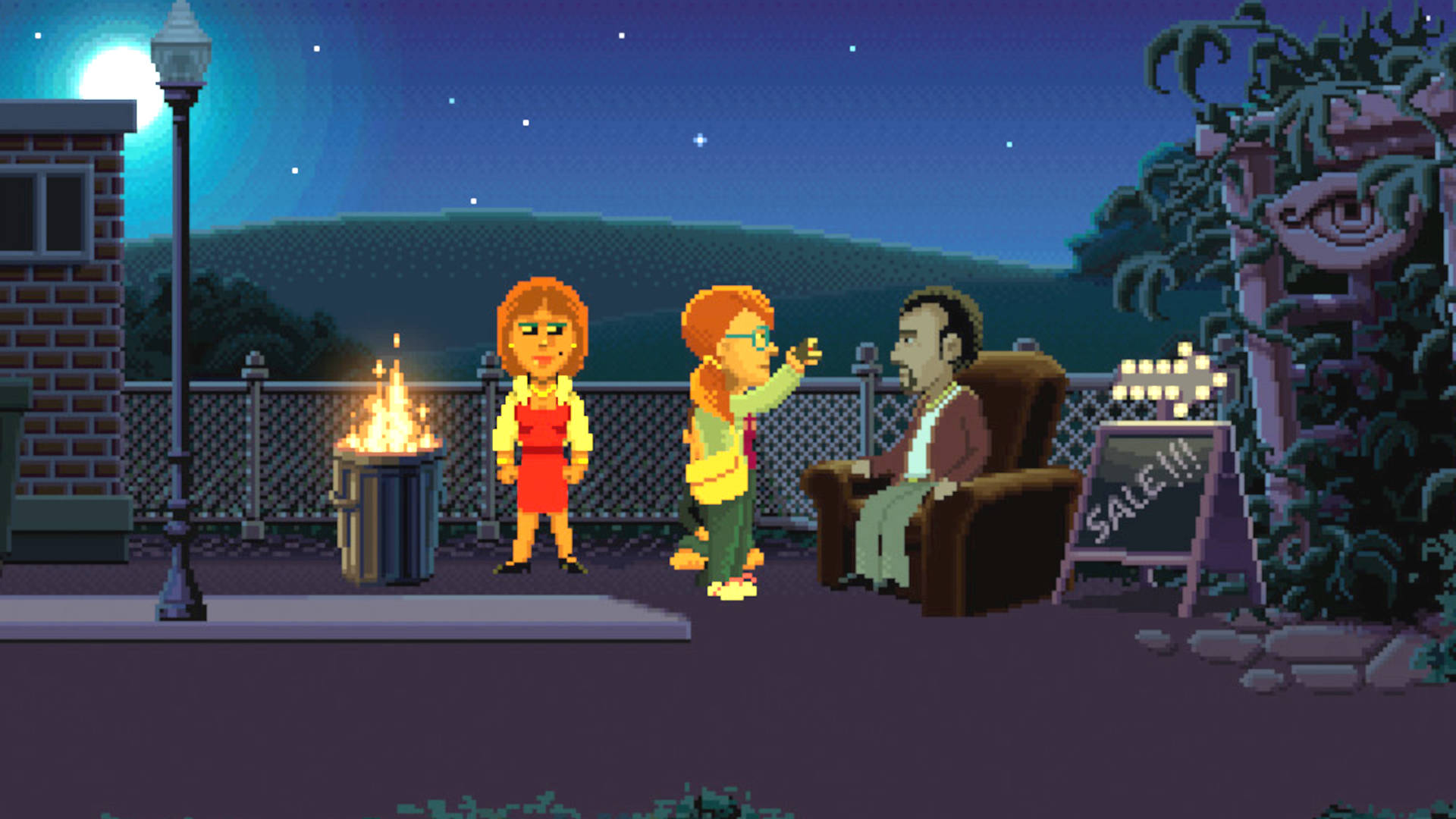
Looking for a roundup of the best free GOG games? There's a reason GOG was formerly known as Good Old Games, and that legacy is alive and well when you peer through the store's pre-2000s catalogue, with arcade gems, sequels you forgot about, and everything in-between represented with gorgeous box art.
Look a little deeper into the vast number of games on offer, and you'll find that some are free GOG games. While you won't find many of the best MMOs for free on GOG, its collection of free single-player games should appeal to anyone looking to give their wallet some rest.
![[GOG] (Other) The Witcher Goodies Collection [GOG] (Other) The Witcher Goodies Collection](https://external-preview.redd.it/XEL8b604pCOZFVLbyTFbIS3tNMbsv1p3lxuikdEpK00.jpg?width=640&crop=smart&auto=webp&s=09926cf7fd850eb41425c1fd60e11e9551817155) |
submitted by /u/bgomes10 [link] [comments] |
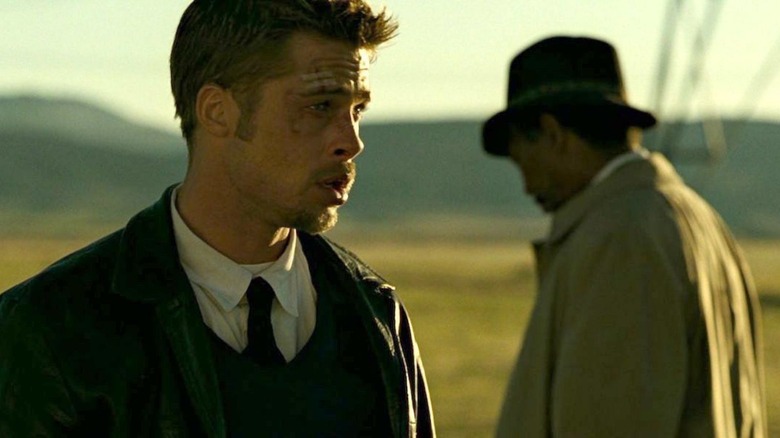
When talking about the best movies and the best movie endings of all time, David Fincher's "Seven" (or "Se7en," if you prefer) is right up there. It has been 27 years since the film was released in theaters worldwide, but just because all that time has passed, it doesn't mean our sentiments toward the film's unbelievably spooky ending have changed.
In "Seven," director David Fincher lets viewers experience the ultimate serial killer movie. The killer commits atrocities that are hard to describe, with a purpose that is laced with unimaginable evil. It also works as a horror movie, because among the film's many terror-inducing scenes, including a dead man face-down in a spaghetti bowl, blood-written messages, and a woman knifed to death, the scariest remains the unseen. It's hard to overlook just how brutal the ending of "Seven" was. It abandoned expectations and convention, only allowing viewers to discover what was inside that box through the dialogue and countenance of its characters. It turns out Brad Pitt fought hard to keep the film's ending intact — he knew it'd be more impactful if we didn't see the unspeakable.
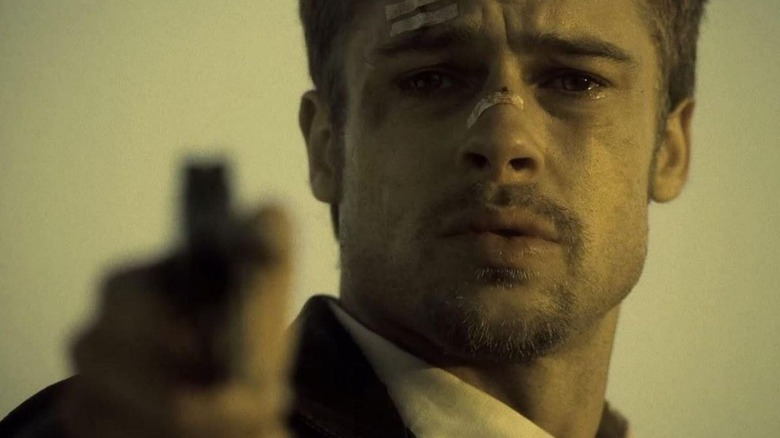
If you don't remember the ending of "Seven" too well, allow me to refresh your memory. After catching John Doe (Kevin Spacey), the killer who had been choosing his victims based on the seven deadly sins, detectives William Somerset and David Mills (Morgan Freeman and Brad Pitt) learn that one of his last two victims is Tracy (Gwyneth Paltrow), the latter's pregnant wife.
Unlike his other victims, Doe doesn't leave Tracy's body somewhere for her detective husband to find. He brings her (well, technically, her head) to him in a box, just when Mills thinks he has the upper hand. The two detectives, utterly distraught, are unable to come to terms with Doe's crime and the extent of its depravity. Mills eventually shoots Doe in absolute horror — he doesn't do the right thing as his colleague persuades him to. He merely gives a reaction.
The leading reason why the scene is so unsettling is we don't see Tracy's head; we envision it. Pitt wanted the movie's ending to evoke emotion in the viewer and fought tooth and nail to make sure Tracy's head stayed in the box and wasn't revealed to the viewers.
In fact, Pitt only agreed to sign on for the film under one condition, making it permanent in his contract. "I said, 'I will do it on one condition — the head stays in the box. Put in the contract that the head stays in the box,'" the actor explained to Entertainment Weekly in 2011.
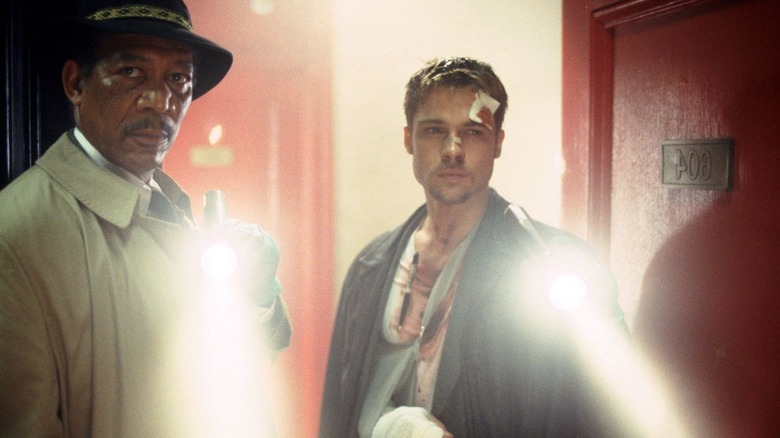
Evidently, Brad Pitt wanted the ending of "Seven" to be frightening without viewers having to experience it. David Fincher had several ideas about the film's haunting conclusion, but Pitt was settled on one. He made sure the severed head remained in the box and that his character killed John Doe. Here's what he said during his EW interview:
"Actually, there was a second thing, too: 'He's got to shoot the killer in the end. He doesn't do the "right" thing, he does the thing of passion.' Those two things are in the contract. Cut to: 'Se7en' has been put together, and they've tested it. They go, 'You know, he would be much more heroic if he didn't shoot John Doe — and it's too unsettling with the head in the box. We think maybe if it was the dog's head in the box ...'"
While the possibility of the dog's head being in the box is pretty tragic, it's much, much worse to imagine a human — Mills' pregnant wife, at that — losing her life in such a violent manner. Ever since the film was released, its twisted turn of events and the harrowing ending have cemented "Seven" as an incredible addition to the world of neo-noir crime cinema.
Read this next: Ranking Morgan Freeman's 20 Best Roles
The post Brad Pitt Did Everything In His Power To Keep Seven's Ending Intact appeared first on /Film.
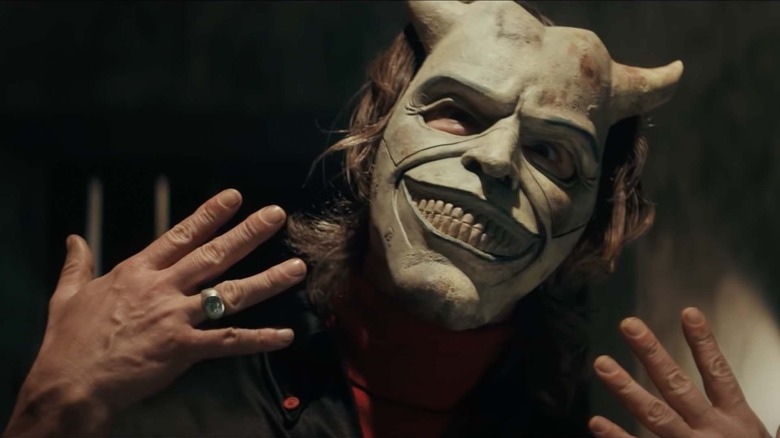
When thinking about the career of Academy Award nominee Ethan Hawke, "creepy" is likely not the first word that comes to mind. Known for his incredible collaborative efforts in Richard Linklater's "Before" trilogy and dramatic roles in films like "Gattaca" and "Training Day," Hawke intentionally spent years avoiding villainous or horrific roles, not wanting to wind up like Jack Nicholson after "The Shining," where people find it difficult to separate the actor from the memorable horror performance. But as he nears his fourth decade in Hollywood, Hawke's feelings about playing horror roles have evolved, with his undeniably unsettling role as The Grabber in the upcoming horror film "The Black Phone" proves.
With "The Black Phone" due out in theaters on June 24, 2022, let's take a look back at some of Ethan Hawke's creepiest performances throughout his career, within the confines of horror and in some very unexpected places.
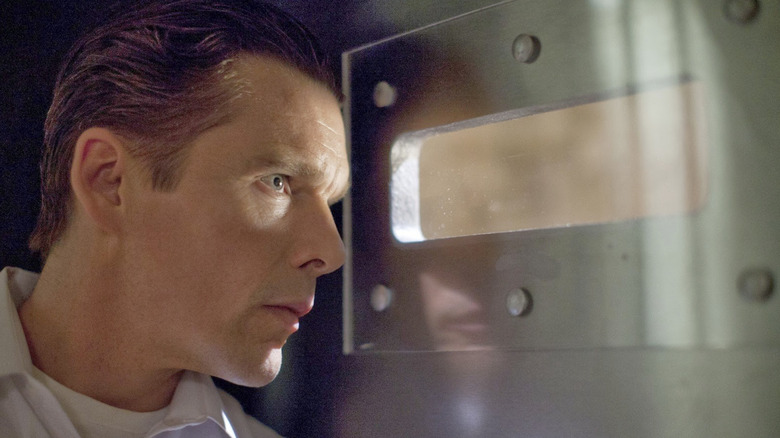
In the wake of "Se7en," the late '90s and early '00s enjoyed a slew of provocative crime thrillers, with Hawke starring in the less-than-well-received flick "Taking Lives." Hawke himself has called the film "terrible," but it does offer audiences the first look at the possibility of viewing him as more than just a dramatic or romantic lead. When Hawke is revealed to be the killer, his demeanor immediately shifts into a menacing territory, showing that he's more than capable of playing dastardly and demented. The film may have been poorly received, but Hawke genuinely delivers a pretty perturbing performance.
Toward the end of the aughts, Hawke starred in the sci-fi/action vampire film "Daybreakers," which shows a world without resources as vampires have replaced humans and the blood supply is running dry. While Hawke's character is not one of the creepier aspects of the film, he feels right at home in this supernatural world surrounded by bloodsuckers. As his character lusts for blood with hunger, one can't help but imagine what could have happened if Hawke had been a "Blade" vampire instead.
Just a few years later, he would star in the franchise-starter "The Purge," as a father trying to protect his family from assailants hoping to kill the Black man seeking refuge in his home. Hawke isn't as creepy as the circumstances surrounding him, but seeing him willingly participate and profit off of an event that results in the mass extermination of mostly poor and non-white Americans surely paints his character in a much more conflicting light.
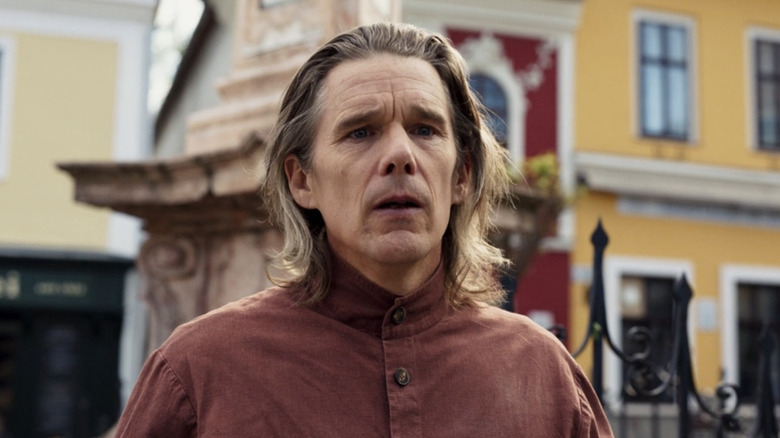
A sports drama is not the first place one would think to look for a creepy performance, but Hawke's role as the abusive father of an up-and-coming baseball wunderkind in "The Phenom" is sincerely difficult to watch. Hawke commits to the performance with all that he has, completely shedding the dreamy exterior many audience members were familiar with after falling in love with him in roles like "Reality Bites."
In a similarly unexpected place to find horror, Hawke recently starred in the absolutely fantastic religious drama "First Reformed." Make no mistake, "First Reformed" is a drama through and through, but witnessing Hawke's Pastor Ernst Toller endure a crisis of faith shows the lengths of human desperation that he is capable of conveying. Creepy certainly isn't the correct word to describe Hawke's performance, but his tortured portrayal is one that will haunt you long after the credits have rolled. His pain is palpable and we as the audience can't help but feel his anguish as our own.
While Arthur Harrow may have been positioned as the villain of Marvel's "Moon Knight" series, Hawke's subdued portrayal was a welcome change to the usual Marvel formula. Rather than express his power or villainy through loud speeches or massive acts of violence, Harrow takes a far more calculated approach, not unlike a spider lulling an unsuspecting victim into its lair. Hawke cited cult leader David Koresh as his inspiration, and anyone who has seen footage of the understated, charming, manipulation of the former head of the Branch Davidians can attest Hawke completely nailed it.
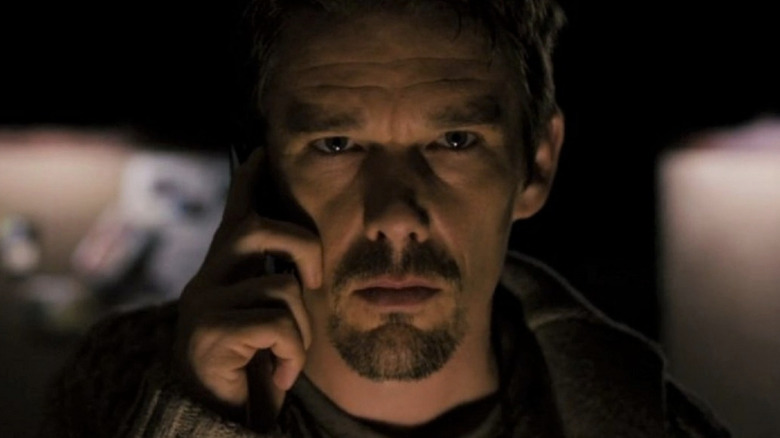
In 2012, Scott Derrickson and C. Robert Cargill crafted what scientists have determined is the scariest movie of all time. In "Sinister," Hawke stars as a true-crime writer named Ellison Oswald who moves his family into the site of a familial annihilation in the hopes that he'll be able to solve the mystery behind the snuff films of their deaths left behind. The more Ellison looks into the previous family's deaths, the more he realizes that there's something far more ... sinister afoot. Hawke is not the big baddie of "Sinister," but the film itself is so genuinely horrifying that every moment of Hawke on screen is creepier than 90% of his filmography. The scares are anchored by Hawke's performance, and if it wasn't for his effortless ability to pull in the audience, they wouldn't work. "Sinister" thrives with the perfect combination of Derrickson/Cargill's disturbing story, Derrickson's pitch perfect direction, and Hawke's phenomenal delivery.
"Sinister" marked a new trajectory for Hawke and helped solidify his professional relationship with Derrickson and Cargill, which would lead to his most creeptacular performance yet. While "The Black Phone" is due in theaters later this summer, /Film has seen the movie, and Hawke is performing on another level. When Derrickson approached him for the role, he left a voicemail to confirm his acceptance by quoting the script and leaving the ominous message of "I'm gonna murder the f*** out of you... It's gonna hurt really, really bad," in-character. We'll save any additional information as to not spoil the nightmare-inducing thrills, but prepare accordingly: "The Black Phone" is going to skyrocket Hawke into horror villain history.
Read this next: 16 Horror Movies That Ruined Everyday Activities
The post Breaking Down Ethan Hawke's Creepiest Movie Moments appeared first on /Film.

Someone is working on a Nintendo 64 Portal Demake running on real hardware.
Demakes of getting more popular by the day, but today we wanted to share something really special – a demake of 2007’s Portal that is running on a modded Nintendo 64. Created by YouTuber ‘James Lambert’, this new video shows the demake running with the Portal gun in a working state, complete with recursive portal rendering. Quite impressive given the hardware limitations of the Nintendo 64 – a console that was released in 1996 and was followed up in 2001 by the GameCube.
You check out footage of the Portal N64 Demake down below:
Those interested can grab this Portal demake via Github right here and play it on a modded N64 console or through a Nintendo 64 PC emulator, although, of course, the latter isn't nearly as cool as playing it on actual Nintendo 64 hardware.
What are your thoughts about this impressive demake on real hardware? Hit the comments down below.
In other Portal demake-related news – earlier this month we covered a Portal demake within Unreal Engine 5 with Ray Tracing. Be sure to check that out if you consider yourself a Portal or demake fan.
Portal was originally released for PC, PlayStation 3, and Xbox 360 in 2007 as part of Valve’s Orange Box bundle.
Portal is a new single player game from Valve. Set in the mysterious Aperture Science Laboratories, Portal has been called one of the most innovative new games on the horizon and will offer gamers hours of unique gameplay.
The game is designed to change the way players approach, manipulate, and surmise the possibilities in a given environment; similar to how Half-Life® 2's Gravity Gun innovated new ways to leverage an object in any given situation.
Players must solve physical puzzles and challenges by opening portals to maneuvering objects, and themselves, through space.
The post This N64 Portal Demake Running on Real Hardware is Looking Promising by Aernout van de Velde appeared first on Wccftech.
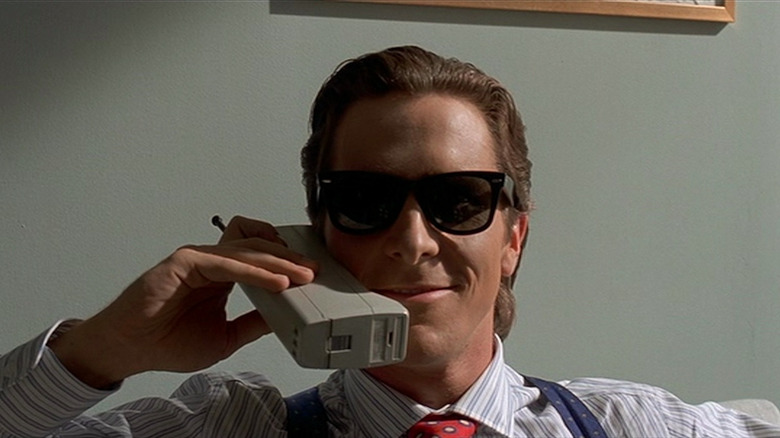
Brett Easton Ellis's 1991 novel, "American Psycho," about a deranged businessman-turned-serial killer, offers up brilliant commentary on the consumer-driven world of the privileged and wealthy in New York City. Made into a film in 2000 that was written and directed by Mary Harron, both versions tell the story of Patrick Bateman, an investment banker who definitely has some psychological issues he needs to work out. The film and the book rely on a dry, satiric sense of humor that enhances the story's criticism of elite society. At the time of its release, it was a controversial film with its gratuitous depictions of violence — especially to women — but it has gone on to become a classic for many film buffs, often referenced in pop and meme culture.
The book and the movie both end with a sense of ambiguity over whether or not Bateman really is the killer he perceives himself to be. Some could see the ending as an open invitation to a sequel, but Ellis has never written one (though it should be noted all Ellis' books exist within the same shared universe, so Bateman does show up tangentially in other stories, the most obvious being "The Rules of Attraction," where he meets his younger brother Sean on the train). However, the people of Hollywood saw potential in creating a sequel to "American Psycho," and so they ran with it. However, what resulted was nothing short of a badly designed business card, leaving many people disappointed, including Ellis.
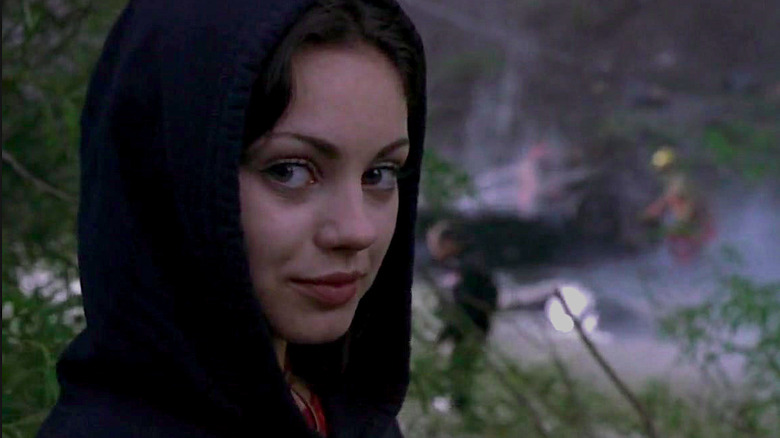
"American Psycho 2" (alternatively titled "American Psycho II: All American Girl") is not really a direct sequel to the events of "American Psycho." Directed by Morgan J. Freeman (No, not that Morgan Freeman), the film stars Mila Kunis in one of her very early roles. The plot is a messy storyline that has little to nothing to do with the events of the first film. Kunis plays Rachael Newman, a college student trying her best to get into the FBI. When she realizes competition is stiff, she begins murdering those she perceives as threats, eventually spiraling out of control. There are a lot of twists and turns to this convoluted sequel, and the only connection to the original Patrick Bateman is he murdered Newman's babysitter when she was a little girl, prompting Newman to murder Bateman with an ice pick on the same night (yes, really).
As one might expect, "American Psycho 2" did not go over well with fans, or with Ellis himself. The movie was sent direct to DVD, and IGN reported on a New York Post story about how Ellis was disappointed at the time. He explained:
"Lionsgate wanted to put a serial killer in 'Rules of Attraction' [the Roger Avary-directed adaptation of an earlier Ellis novel]." But Avary said no, and that's when they decided to make 'American Psycho 2.'"
He explained the studio even thought about turning "American Psycho" into a franchise with versions taking place in cities all over the country. "If they're not careful they could end up with something like 'The Pink Panther' movies," said Ellis. For the author, the book and the movie are two separate beasts, and thankfully he also felt "none of these movies has blotted out the book for the reader." It's great that Ellis feels this way because "American Psycho 2" would be enough to make any writer feel enraged over what Hollywood chose to do with their original creation, especially since the sequel is a far cry from its original source material — which, it turns out, there's a reason for.
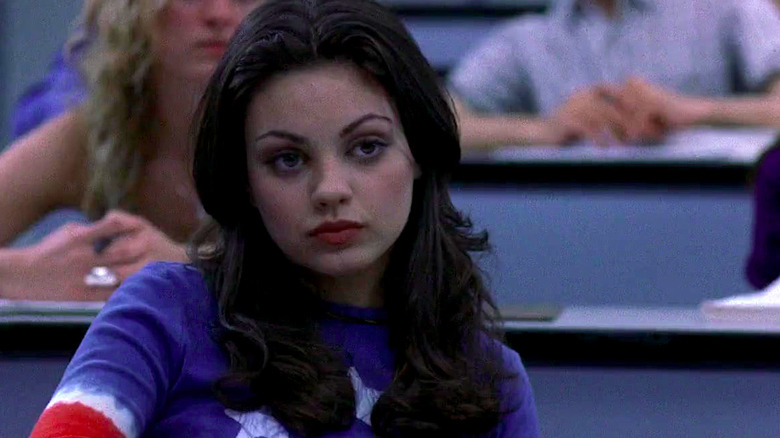
You see, "American Psycho 2" was never even supposed to be a direct sequel to Mary Harron's film. Originally titled "The Girl who Wouldn't Die," the movie was slated to be a stand-alone story that didn't have nary a thing to do with Patrick Bateman and his psychopathic ways. But because the film was slated to be released direct to DVD, profit was a big motivator, causing the production company to rebrand the movie as a sequel to "American Psycho." This is, unfortunately, not that uncommon in Hollywood (Disney is a big fan of this marketing move), but it also means audiences end up with Very Bad Movies associated with otherwise great franchises or films.
Even Mila Kunis hates the film and tried to get production stopped on it out of fear that it would blemish her resumé. In an article for MTV, Kunis said:
"Please — somebody stop this. Write a petition. When I did the second one, I didn't know it would be 'American Psycho II.' It was supposed to be a different project, and it was re-edited, but, ooh ... I don't know. Bad."
Thankfully, although the movie was ultimately released despite her pleas, Kunis has gone on to have an extremely successful career, and "American Psycho 2" has become nothing more than a blip on the radar of her impressive filmography.
Read this next: The 13 Best Movies About The Devil Ranked
The post How Bret Easton Ellis Truly Feels About the American Psycho Sequel appeared first on /Film.
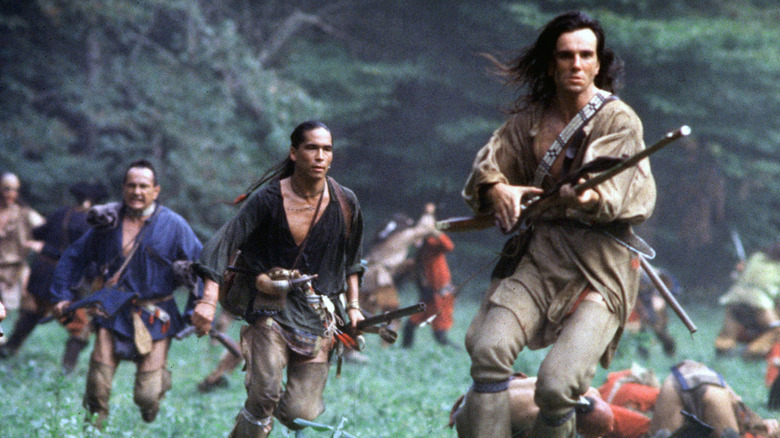
Some say getting away from it all is a great way to recover from stress, and no one does it quite like Daniel Day-Lewis. For his next film role after his very public breakdown on stage during a performance of "Hamlet," the famously intense actor took himself off to the wilderness to prepare for "The Last of the Mohicans."
Day-Lewis is well known for his commitment to method acting. Prior to taking on the role of Nathaniel "Hawkeye" Poe in Michael Mann's dashing adaptation of James Fenimore Cooper's historical yarn, he had stayed in character to portray Christy Brown in "My Left Foot." Brown was born with cerebral palsy, so Day-Lewis refused to leave his wheelchair during the shoot, resulting in crew members carrying him over lighting cables on set and feeding him at meal times. The hard work paid off with his first Oscar triumph.
For the part of Hawkeye, Day-Lewis underwent a strict training regime to build up his physique and stamina before heading to the woods of North Carolina to immerse himself in the survivalist lifestyle (via New York Times):
"Day-Lewis learned to track and skin animals, build canoes, fight with tomahawks, fire and reload a 12-pound flintlock on the run. The gun, because it never would have left the side of a hunter in the wild, went everywhere with Day-Lewis, including Christmas dinner."
As always, Day-Lewis' passion for losing himself in a character paid dividends for the finished film, but once again, it took a toll on his mental health.
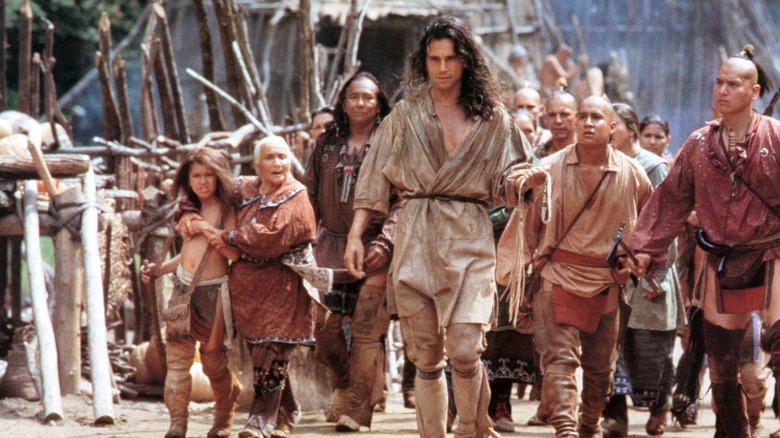
It is 1757, and the British and French are battling for control of the American colonies. The British are putting pressure on local settlers to leave their families at the mercy of marauding Huron war parties to form a militia and lend reinforcements to the heavily outgunned Fort William Henry by Lake George, NY.
Stuffed shirt British Major Heyward (Steven Waddington) arrives and is given the task of escorting his would-be fiancee, Cora (Madeleine Stowe) and her sister Alice (Jodhi May) to their father, Colonel Munro (Maurice Roeves), who is in command of the besieged fort. He is assigned a unit of soldiers and a guide, Magua (Wes Studi), a vengeful Huron chief working for the French who is posing as a friendly Mohawk.
Magua leads the party into an ambush where most of Heyward's men are killed. Luckily, Nathaniel "Hawkeye" Poe (Day-Lewis) is hunting nearby with his adopted father, Chingachgook (Russell Means) and brother Uncas (Eric Schweig), and comes to the rescue. They agree to help Heyward escort the two women to the relative safety of the fort.
During their travels, Hawkeye and Cora fall for each other, which doesn't go down well with Heyward. Reaching the fort, Colonel Munro is initially grateful for saving his daughters' lives, but then charges Hawkeye with sedition for helping militia men escape to protect their families. Before the sentence can be carried out, Munro is forced to surrender the fort to the French commander, who guarantees their safety. The treacherous Magua has other ideas...
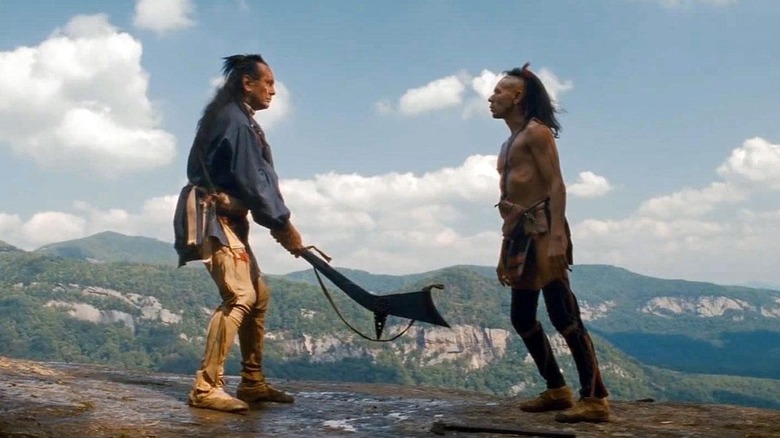
In his review for "A Time to Kill," Roger Ebert wrote that "the movie is interested in white people as characters and the black characters... as atmosphere." Despite the efforts of Day-Lewis, Michael Mann, and his production crew to make the film as authentic as possible, there is an element of this in "The Last of the Mohicans." The Native-American actors, especially Means, Studi, and Schweig, all cut impressive figures, but it is still very much a film about white people's problems set against a historical backdrop where the natives' allegiances were torn between two colonizing forces. There is an attempt to build a second romance for Uncas and Alice, but that feels very underfed compared to the instant magnetism between Hawkeye, an English orphan raised by a Mohican family, and Cora, an upper-crust English woman.
As a historical romantic adventure, "The Last of the Mohicans" is hard to beat. The cinematography is lush and the score is simply irresistible. My mum absolutely loves this movie, but I only ever saw bits of it until recently. I just didn't fancy it before, but now I understand. It's a gloriously old-fashioned swashbuckler, which Mann (who co-wrote the screenplay) based on the 1936 Randolph Scott adaptation rather than Cooper's novel, adding the romance element that didn't exist in the book. It takes a while to get fully going, but once you reach that epic finale at the waterfall it's hard not to swoon at its passion and sweep.
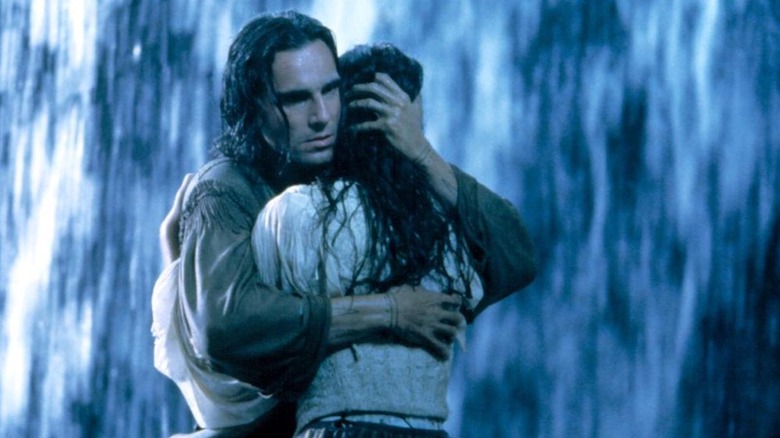
Daniel Day-Lewis's performance as Hawkeye is fairly low-key compared to later grandstanding roles like Bill the Butcher in "Gangs of New York" and Daniel Plainview in "There Will Be Blood," but his commitment to authenticity earned the respect of Russell Means, the Native American activist who plays Chingachgook in the movie (via New York Times). Means said that Day-Lewis is "one of the most considerable human beings I ever met... Daniel is the embodiment of someone I would adopt as a non-Indian."
Day-Lewis's hard work really shows in the gripping finale, charging full tilt across a rocky precipice, unloading a rifle into an enemy on the run and, without breaking stride, dropping it and picking up his vanquished foe's weapon in its place. It's a lean and muscular performance where Hawkeye's actions and silent reactions speak louder than his words. Which, coming from the lips of an actor of Day-Lewis's caliber, sure pack a punch as well. Once again, Day-Lewis stayed in character during the shoot:
"He didn't seem to allow himself anachronisms. Between scenes a few of the Mohicans shared a Marlboro, stubbing it out with their moccasins; Hawkeye rolled his own cigarettes. While redcoats in reflective sunglasses would strap on their Walkmans or touch up their beards with electric razors, Day-Lewis tended to go off by himself and sit under a tree in the sun."
It was a tough shoot, and Day-Lewis reportedly suffered claustrophobia and slight hallucinations afterwards, having once again put his mental well-being on the line and proving himself one of the hardest working modern-day actors.
Read this next: Horror Roles That Changed Actors Forever
The post The Last of the Mohicans Took Its Toll On Daniel Day-Lewis' Mental Health appeared first on /Film.
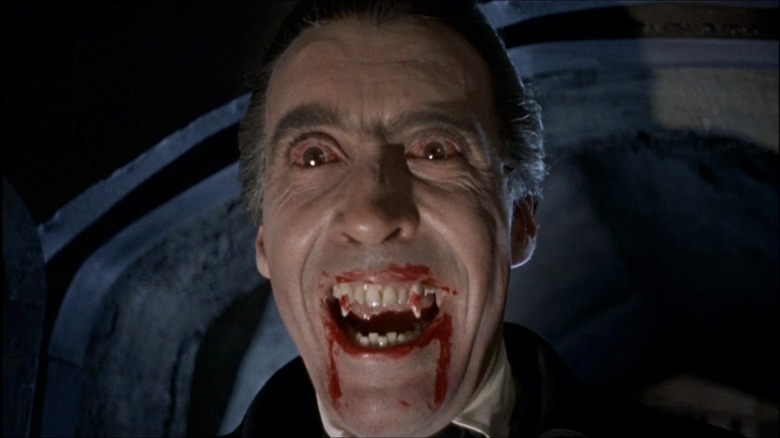
When cinephiles think Dracula, there are any number of actors whose faces might come to mind, from Bela Lugosi to Gary Oldman or even the more recent Claes Bang, who ushered in the 2020s with a three-episode miniseries on Netflix and BBC One. Bang certainly wasn't the first gent to star in a British adaptation of Bram Stoker's foundational vampire novel. Perched halfway between Lugosi and Oldman was the Hammer Horror reign of Christopher Lee, who played Count Dracula in seven films across 15 years from 1958 to 1973.
To put this in perspective, Lee played Dracula for Hammer for the same length of time that Daniel Craig played James Bond for Eon Productions. And he starred in an additional three films outside the Hammer oeuvre, bringing his total number of Dracula appearances up to 10, twice as many as Craig had with Bond. That's not even counting his cameo in an 11th film, which features as an honorable mention on some lists.
21st century viewers may associate Lee with his role as the wizard Saruman in the "Lord of the Rings" and "Hobbit" trilogies, but to a whole generation of filmgoers, he was Dracula. Likewise, Peter Cushing was better known as the vampire hunter Van Helsing before he ever played Grand Moff Tarkin in the first "Star Wars" movie (or was digitally resurrected, rather like a Disney vampire, in "Rogue One: A Star Wars Story"). Even Michael Gough, who co-starred as Alfred the butler in all four of the Tim Burton and Joel Schumacher "Batman" movies, was part of the same Hammer Horror gang with Lee and Cushing, first.
The point is, all your favorite modern franchises drew from the acting well of Hammer's 1958 "Dracula" film adaptation, often referred to by its U.S. title, "Horror of Dracula." This is where Lee first spread his vampire bat wings, figuratively speaking. (He would turn into an actual bat in later movies.)
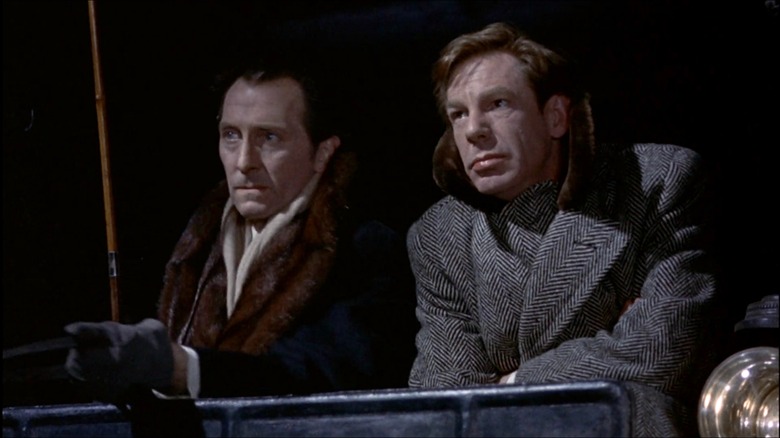
In a word: teeth. Onscreen, the traditional image of vampire fangs (as opposed to Count Orlok's rodent-like incisors) didn't really exist until the 1950s. "Horror of Dracula" is what mainstreamed them after they first appeared in a lesser-known Turkish film called "Dracula in Istanbul" in 1953.
Hammer upped the sex-and-violence quotient, dripping blood down over the movie's title and showing us a bride of Dracula (Valerie Gaunt, credited as "Vampire Woman") with more cleavage and a phallic wooden stake being driven into her chest. Lee's Dracula comes at the viewer with red eyes and blood all over his mouth, but he proves just as capable of being sophisticated and sensual when the moment calls for it.
What's ironic is that the Count in "Horror of Dracula" is essentially a serial monogamist. His presence is overwhelming, and he seduces every woman in his path, but he's really just trying to come up with a replacement bride for the one that his impertinent house guest, Jonathan Harker (John Van Eyssen), slayed. This sets him apart from other Draculas, who usually have no less than three brides and are always on the prowl (sometimes as literal wolves) for others to ravish in acts of bestiality.
The Harker in "Horror of Dracula" arrives fully formed as a vampire hunter who is already looking to end the Count's reign of terror. He foregoes the usual coach ride and makes his way to the castle on foot like Peter MacNicol in "Dracula: Dead and Loving It." There are no birds singing outside, and this time, he's there to act as a librarian instead of a real estate agent.
"Horror of Dracula" diverges further from the source material when it has Harker become a full-on vampire. You could maybe even say he's Dracula's first replacement bride. They do sleep in the same coffin, before Harker's old vampire hunting partner, Van Helsing, retraces his steps to the castle and puts him down.
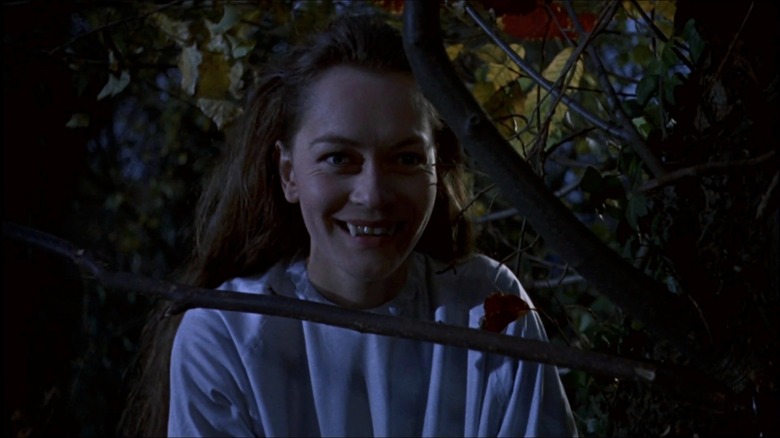
Written by Jimmy Sangster and directed by Terence Fisher, who would reunite with Lee and Cushing on "The Mummy" in 1959, "Horror of Dracula" plays loose with character names and narrative roles, mixing and matching them so that Mina Harker is Mina Holmwood (Melissa Stribling) and Lucy Westenra is her sister-in-law, Lucy Holmwood (Carol Marsh). The movie has a condensed 82-minute runtime, and when we first meet Lucy, she already bears bite marks on her neck and is in the grips of vampirism. It's not the kiss of death; it's the kiss of Dracula.
It's also an early example of vampirism as a metaphor for drug addiction on film — something future genre entries like Bill Gunn's "Ganja & Hess" and Tony Scott's "The Hunger" would further develop, with the latter movie arriving amid the AIDS crisis. Van Helsing spells it out in "Horror of Dracula" when he says, "Victims consciously detest being dominated by vampirism, but are unable to relinquish the practice, similar to addiction to drugs."
Lucy's transformation is particularly horrifying, as she goes from being a pliant, pigtailed victim to a would-be victimizer of children: grinning evilly through tree branches at the maid's daughter and leading her by the ice-cold hand through the woods to a cemetery. "Come, let me kiss you," she tells Arthur, who, like Dracula's one lonely bride, serves as the reduced form of three vampire hunters in this adaptation (with the Texan Quincey P. Morris and the asylum director Jack Seward being absent).
Arthur acts as a skeptical foil to Van Helsing at first, but this changes at the sight of his own undead sister, cowed by a cross, which burns and brands her forehead. Staking Lucy restores her human beauty, unlike the withered crone of a corpse left by Dracula's castle bride.
Mina receives Lucy's blood transfusion from the book, well ahead of films like "Near Dark," and "Horror of Dracula" puts another twist on things by having the Count nest right in the Holmwoods' own cellar instead of Carfax Abbey. He's defeated by daylight through stained glass windows, and if his screen time feels disproportionate to that of the other characters, just remember that Lee would come back from the dead nine more times.
Read this next: The 95 Best Horror Movies Ever
The post Year of the Vampire: In Horror of Dracula, Christopher Lee Gave the Genre Its First Real Teeth appeared first on /Film.
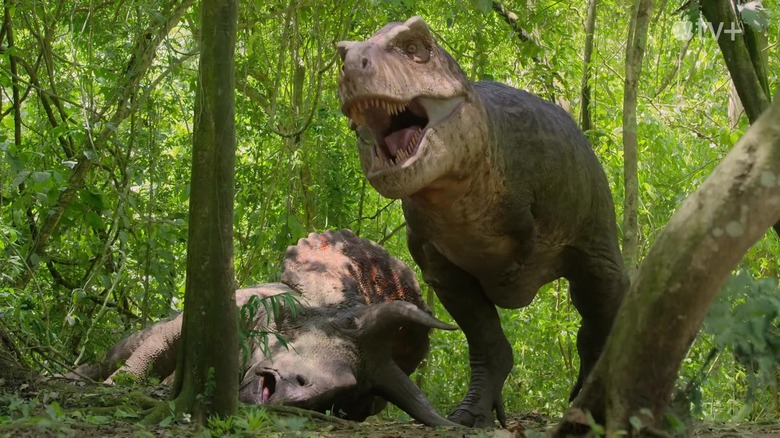
A mighty Tyrannosaurus rex swimming; a ferocious Velociraptor flexing its deadly, distinctive claw; Suropods showing off bulbous neck sacks — these are just some of the stunning visuals in the trailer for "Prehistoric Planet," the new Apple TV+ documentary series about life on Earth "66 million years ago."
This might be the most ambitious nature documentary to date: produced by Jon Favreau and Mike Gunton for BBC Studios Natural History Unit ("Planet Earth") and narrated by Sir David Attenborough, the new docuseries is epic in every sense of the word. The visuals reflect the best available technology — and the content, the most interesting and up-to-date theories from paleontologists. Heck, even the music is by Academy Award-winner Hans Zimmer. As another Attenborough known for his work with dinosaurs once said, they "spared no expense."
"Jurassic Park" jokes aside, "Prehistoric Planet" is, in many ways, a spiritual successor to the groundbreaking, 2006 BBC TV documentary series "Planet Earth." That nature documentary rewrote the rules: it was shot in high-definition, it was incredibly expensive, and it won a ton of awards. Like "Planet Earth," "Prehistoric Planet" aims to delight and surprise. The unbelievably weird-looking pterosaurs, which have enormous beaks and wings that fold backward for walking on like giant canes; the majestic plesiosaur cresting massive freshwater lakes to gobble up desperately leaping fish; the nimble (and very bird-like) velociraptor gliding and skipping down an impossibly steep cliff; the massive titanosaur, fighting for dominance in the herd — all gloriously rendered in ultra-realistic CGI. It's breathtaking.
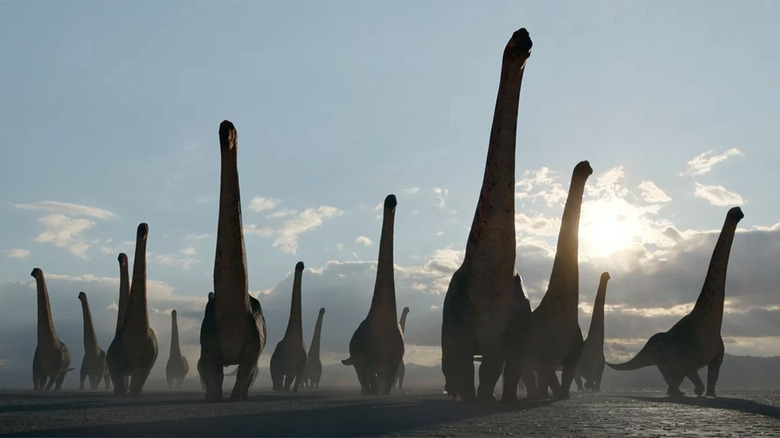
Great lengths are taken in "Prehistoric Planet" to make the footage as immersive as possible, offering a believable (if unique) view of life millions of years ago. In episode 2 "Deserts," there's a shot from inside of a Sauropod carcass of Pterosaurs, pecking at the rotting flesh. When one of the hungry reptiles gets too close to the "camera," the screen jiggles. Later in the same episode, plants are shown growing in a once arid region, and rather than smoothly animating the growth, audiences are treated to a time-lapse shot often found in BBC nature documentaries. It's the attention to detail in moments like these that make it easy to forget — if only momentarily — that what we're watching is completely man-made.
This is a thoughtfully produced series. The violence is handled well — unlike some other similar documentaries (I had to turn off "Dinotasia," the 2012 movie narrated by Werner Herzog, because the high level of gore was inappropriate for my kids). For example, rather than showing a beloved triceratops getting ripped to shreds by a T Rex, "Prehistoric Planet" shows blood dripping off of leaves and a fly landing on an unblinking eye — signaling what's going on to knowing viewers, leaving the young ones blissfully unaware. Potentially upsetting moments — like babies getting eaten (this is a nature documentary, so that's to be expected) — are framed at a distance. Having said that, the events don't come across as sanitized or dumbed-down either.
This is definitely a series that people of all ages can enjoy. The music is perfect, oscillating from lofty to jolly to solemn and back again. A high point is a particular courtship display in episode 5, "Forests." The moment is a bit unexpected, and the score sets the tone superbly. Even the most joyless viewer couldn't watch that scene and not crack a smile.
Attenborough sounds to be having the time of his life narrating the CGI action in "Prehistoric Planet," putting the right amount of amusement in lines like, "The facial area of a Tyrannosaur is very sensitive to touch. And they nuzzle." (Admittedly, the romantic closeups on the dinos' faces during the mating scene — their bodies tastefully obscured by leaves and shadows, of course — is a bit much. I blushed.) His tone can be bemused, dramatic, or deadly serious — providing some emotional depth to the action onscreen. Attenborough really is the best in the biz when it comes to narrating nature documentaries (sorry Oprah Winfrey), and he brings his A-game here.
The thematic divisions were clever and worked well, demonstrating the prehistoric creatures in an ecology; however, the lines between what is speculative, what is certain, and what is creative license is really unclear — and that hurts the series as a pedagogical tool. Overall, it felt more geared towards entertainment than education. Scope is a bit of an issue here too: while some scenes were great for demonstrating the relationships between various creatures in the ecosystems, others felt very isolated and overly focused on one particular species. This is made worse by how similar all the pterosaurs look — and how much time is spent on enormous colonies of them on barren cliffs and beaches.
Overall, the series struggles a bit from a lack of usable information. As the mother of a particularly prehistoric-preoccupied three-year-old, I have a pretty good ear for terms like "Camptosaurus" and "Stygimoloch," which are mumble-spoken on a daily basis. But even I had trouble keeping track of what species was onscreen, how big they were, and where in the world the action was happening. I often wished that information would appear as text at the bottom, if only for a minute, just to help me keep track.
Even with those minor annoyances, "Prehistoric Planet" was an absolute joy to watch. It satisfied the aspiring paleontologist in me, as well as my inner child. I only wish that I had had the opportunity to see the series on an IMAX screen — these kind of lush, photorealistic displays of grandiose beings are just begging to be shown on the best, and biggest, screens available.
/Film Rating: 8 out of 10"Prehistoric Planet" premieres as a five-day event, with a new episode dropping daily from Monday, May 23 through to Friday, May 27, on Apple TV+.
Read this next: 20 Underrated Rom Coms You Need To Watch
The post Prehistoric Planet Review: Jon Favreau and David Attenborough Deliver A Docuseries For The Ages appeared first on /Film.
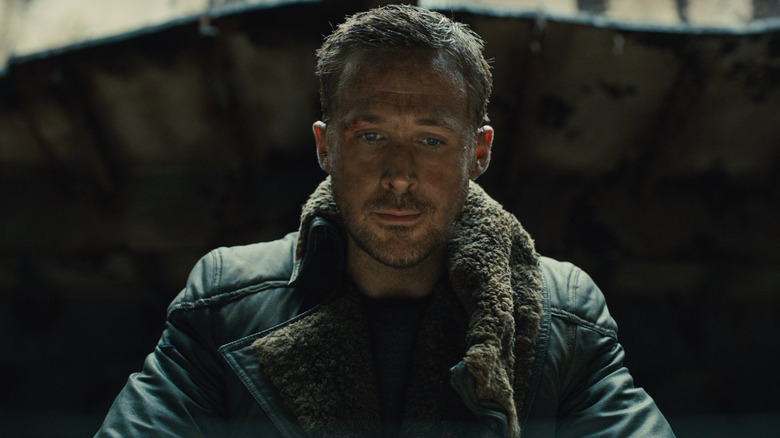
Ryan Gosling is taking a detour from Barbie world to take a trip down under. Per Variety, the actor is set to star in "The Fall Guy," a feature film adaptation of the 1980s TV series of the same name, that will shoot in Sydney, Australia. The original series starring Lee Majors ran from 1981 to 1986 and followed the life of a Hollywood stunt man with a side hustle as a bounty hunter to make ends meet. Major's character Colt Seavers used disguises and a skilled team of fellow stunt performers to hunt down "swindlers, thieves, bikers, conmen, fugitives, corrupt officials and more." Their Hollywood knowledge made their gambit possible as they caught criminals across the state.
Last we heard, the film was set to be directed by David Leitch, the former stunt man known for co-directing "John Wick" and more recently helming "Deadpool 2," "Hobbs and Shaw," and the upcoming Brad Pitt thriller, "Bullet Train." Universal landed the rights to "The Fall Guy" after a competitive bidding war and now filming is set to begin in Sydney later this year. According to Paul Fletcher, Federal Minister for Communications, Urban Infrastructure, Cities and the Arts, "the production is expected to inject more than A$244 million ($171 million) into the Australian economy." With the film partly set at a film studio, it also presents a unique opportunity to spotlight Sydney's film studio facilities and landscape. In a statement, Fletcher said:
"We are pleased to welcome The Fall Guy down under with $30 million ($21.1 million) in support from our highly successful Location Incentive, with the production to employ over 1,000 Australian cast and crew, and more than 3,015 Australian extras."
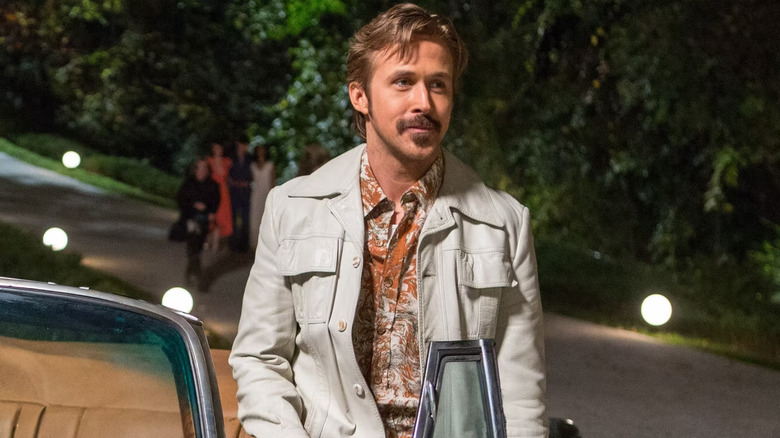
"The Fall Guy" has been in talks for a big-screen adaption since 2010 — Dwayne Johnson was once in negotiations to play the role originated by Majors. This version of the film was expected to be helmed by Martin Campbell ("Memory," "Casino Royale"). When plans fell through, a new version of the script entered development and now, the film starring Gosling is more loosely based on the series.
While it's not hard to see why Johnson was in talks for a stunt-man-based action flick, it's hard to imagine a more exciting team-up than Gosling and Leitch. For one thing, Gosling has lots of experience playing a stuntman — having played a stunt driver on two separate occasions in "Drive" and "The Place Beyond the Pines." He even has some experience as a bounty hunter, thanks to "Blade Runner: 2049," so he might just be uniquely suited for this particular role. But maybe it's the 70's California vibe or just my hope that this film will be equal part action-packed and hilarious — the best comparison for hype might be "The Nice Guys," where Gosling stunned a PI with a penchant for getting injured. The buddy-comedy sees Gosling showcasing his comedy chops with plenty of action around every corner; "The Fall Guy" sounds like an opportunity for more, with even more impressive action to boot. As for Leitch, this project was previously dubbed "extremely personal" for the director who has first-hand experience as a stunt performer. This has already manifested in impeccably directed action but this added meta-layer of a film about a stuntman means the character himself will be drawing on his experience to survive his dangerous side hustle. Who better to guide the performance than Leitch?
Read this next: Batman Movies Ranked From Worst To Best
The post Ryan Gosling in Talks to Star in The Fall Guy Feature Adaptation appeared first on /Film.
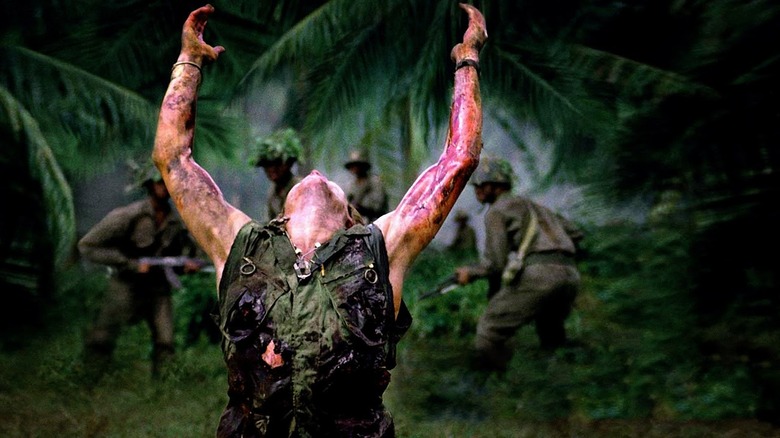
In 1986, director Oliver Stone pulverized moviegoers with his landmark Vietnam War drama, "Platoon." Released just eleven years after the fall of Saigon, the Best Picture-winner stars Charlie Sheen as Chris Taylor, an idealistic young U.S. Army volunteer who finds himself caught in an internecine, life-or-death struggle between the humane Sergeant Elias (Willem Dafoe) and the homicidal Staff Sergeant Barnes (Tom Berenger).
It's a brutally realistic depiction of a conflict that made little sense to the soldiers thrust into it, all of which is sagely summarized in Taylor's narrated letters home to his grandmother. These voiceovers are the key to understanding the movie, which climaxes with the platoon's captain ordering a stunningly chaotic air raid on his company's overrun position. It's a mad swirl of destruction punctuated by Taylor's execution of a badly wounded Barnes. How did it come to this, and what does this wanton death and destruction mean?
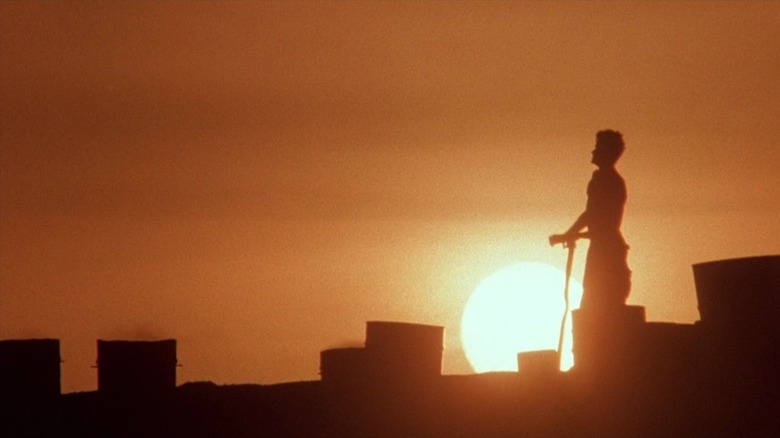
Early in the film, Taylor tells his grandmother that he is in Hell. He quotes an uncited writer who once described the underworld as a locale governed by "the impossibility of reason." Though he finds solace in Elias's marijuana-laced wisdom, he is equally galled by Barnes' abject cruelty and dedication to "the machine." Both sergeants follow their orders, but Elias does so ruefully. Elias confesses to Taylor that Vietnam is a losing campaign. "We been kicking other peoples asses so long, I figure it's time we got ours kicked." Barnes is a true believer in the process. He relishes a fight, and he detests Elias' pot use. "I am reality," he boasts.
Barnes' hatred extends to the people he's charged with defending. When the platoon, smarting from a sneak attack that killed three of its members, discovers a stash of weaponry in an otherwise peaceful village, Barnes executes the wife of the community's leader out of sheer, reasonless fury. The platoon burns the village to the ground. Myriad war crimes are committed. An investigation is in the offing, and Barnes is determined to thwart it.
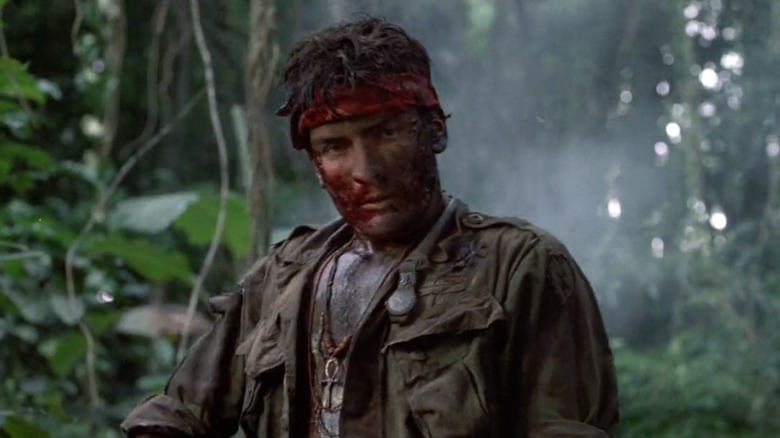
Well aware that Elias will testify against him in a court martial, Barnes mortally wounds his bête noire during a ferocious firefight (Elias's valiant, Christ-like charge back to the evac spot is the film's poster image). But the only way he'll be clear of a court martial is to kill Taylor. In the midst of a savage final battle, Barnes turns his attention away from the enemy to target Taylor. He's about to murder our protagonist when the aerial ordnance blasts the entire location to hell. When the smoke clears, Taylor rises from his scorched stupor, happens upon Barnes and does the only reasonable thing: he kills the war-addled monster.
As Taylor is flown out of the decimated area, he writes one last letter to his grandmother. "I think now, looking back, we did not fight the enemy. We fought ourselves. And the enemy is in us." In this moment, Stone captured the contentiousness of the Vietnam era and predicted the reason-free Hell to come.
Read this next: The Best Movies Streaming Right Now: Malignant, A Hero, And More
The post Platoon Ending Explained: A Mad Swirl of Destruction appeared first on /Film.
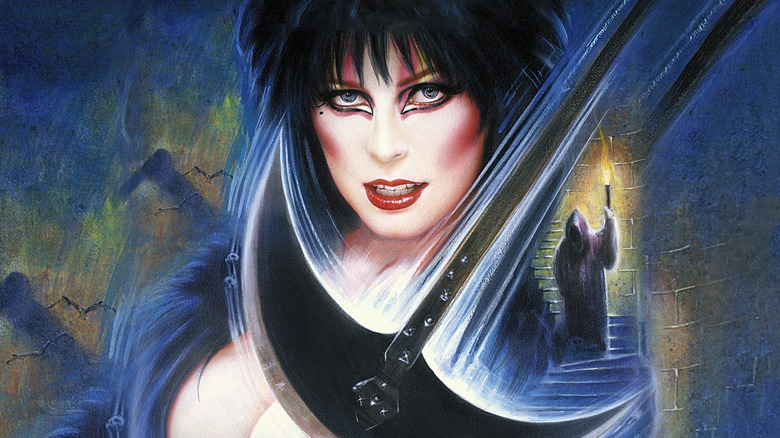
Rob Zombie has always been a big fan of the 1964 sitcom "The Munsters," and he details the exact reasons why on a commentary track he recorded for the 1966 feature film spinoff "Munster, Go Home!" It was on that commentary track that Zombie succinctly separated The Munsters from their ghoulish sitcom contemporaries The Addams Family: "The Munsters were people who look like monsters, and the Addams family were monsters who look like people." And while the Addams have received multiple high-profile feature films since the 1990s, the Munsters' film projects have remained obscure; apart from "Go Home!," there has been a 1973 animated film called "The Mini-Munsters," a 1981 made-for-TV movie called "The Munsters' Revenge," a 1995 reboot called "Here Come the Munsters," and a 1996 Holiday special called "The Munsters' Scary Little Christmas." The most recent Munsters endeavor was a 2012 pilot for an unmade series called "Mockingbird Lane" with Jerry O'Connell as Herman, Portia di Rossi as Lily, and Eddie Izzard as Grampa.
Zombie's new feature film of "The Munsters," set to debut in theaters and on Peacock later this year, will -- contrary to what the filmmaker has previously made -- be a friendly, PG-rated romp for horror-loving kids and adults. This has always been a dream project for Zombie, and reports from the set reveal a good deal of enthusiasm. The cast will include Sheri Moon Zombie (natch) as Lily, Jeff Daniel Phillips as Herman, and Daniel Roebuck as Grandpa. Also appearing in the film is "31" actor Richard Brake and, most excitingly, Cassandra Peterson -- Elvira herself -- as Barbara Carr, the real estate agent who handles the famed mansion at 1313 Mockingbird Lane.
Why did it take so long for Zombie to cast Peterson in a film? She explained why in a recent interview with Rolling Stone.
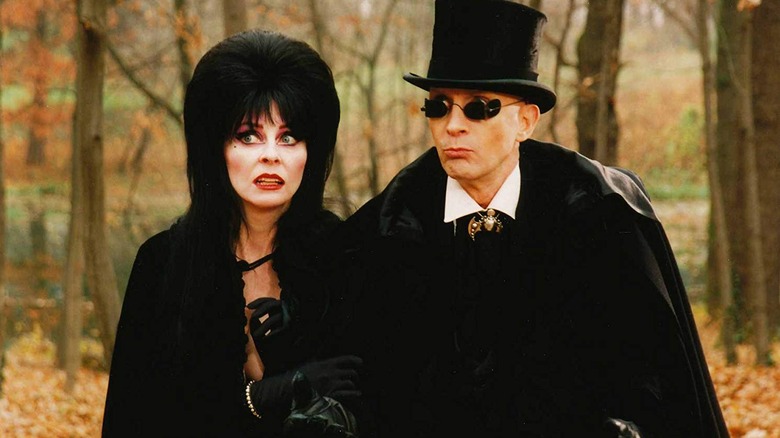
Peterson has been a mainstay in the horror community for decades, with Elvira appearing in feature films, as the hostess of her own horror movie program, and a general media personality; she has more than one pinball machine. As such, she has likely stayed on top of certain horror movies, horror musicians, and other such trends. It should come as no surprise, then, that she is friends with Zombie7. In the Rolling Stone interview, Peterson revealed that she had asked Zombie about appearing in his films:
"Well, I think the thing I'm most excited about is working with my friend Rob Zombie who I've known for like 40 years, I've known Rob. And I'd always say, 'Rob, when are you going to put me in one of your movies?' And he was always sweet, and he said, 'You're not old and haggy enough-looking.'"
Zombie's feature films to date -- including "House of 1000 Corpses," "The Devil's Rejects" and "The Lords of Salem" -- have been notoriously rough and filthy, and often feature older characters in central roles; Zombie rarely makes films about teenagers, his two "Halloween" films being the exceptions. Peterson jokingly concluded that Zombie was just waiting for her to reach the proper age:
"So, I guess I finally got old and haggy enough for him, because he finally put me in the movie and I play a very, very different character than I've ever played – really super straight."

Peterson has acted in numerous projects over the years, starting as an uncredited dancer in the James Bond film "Diamonds are Forever." She acted opposite Cheech and Chong, Pee-Wee Herman, and the Super Mario Bros. For the past 20 years, her film and TV appearances have been mostly as Elvira, making the character of Barbara Carr a sizeable change of pace for Peterson. In the Rolling Stone interview, she pointed that out, as well as who Barbara Carr is:
"A little inside secret is Rob named my character after his real estate lady who is also my real estate lady -- happens to be the same person. So, anyway, I'm playing my own real estate lady."
Peterson gave no word as to whether or not the real Carr knows about her appearance in "The Munsters," although the person who has sold houses to both Elvira and Rob Zombie would presumably be flattered. Zombie and Peterson live in Los Angeles, so if you are a spooky character looking for a home in that area, and you should meet a realtor named Barbara Carr, be sure to say hi.
Read this next: Alfred Hitchcock's 20 Best Films Ranked
The post Cassandra Peterson's Role In Rob Zombie's Munsters Was Decades In The Making appeared first on /Film.
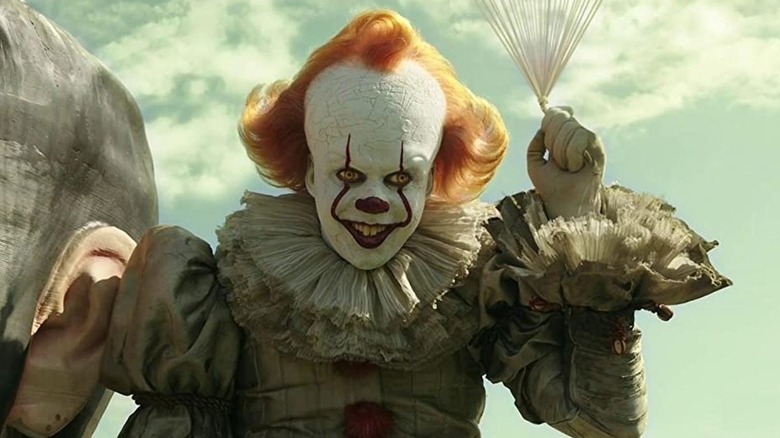
Welcome back to /Film Showdown, wherein we pit a pair of genre giants against each other in a hypothetical Thunderdome to see who would triumph. So far we've seen Leatherface go up against the Priest of the "Hellraiser" films, Obi-Wan Kenobi face-off against Spock, and Magneto vs. Agent Smith. Today, /Film enters darker territory to speculate on a brawl between two mean distillations of evil. One is the creation of fiction maestro Stephen King, the other a creation of horror master Wes Craven. It's time to get ready to rumble with Pennywise the Dancing Clown of King's "It" and Freddy Krueger of Craven's "A Nightmare on Elm Street." Be excited, be passionate, be anything but afraid -- because that's exactly what these two scoundrels want.
The shape-shifting creature of "It" takes on an array of forms; it can take on the likeness of spiders, lepers, possibly crossover bad guys from other King tales, and a Universal monster or two – each child gets a custom-made night terror tailored to the specific boogeyman that lurks under their bed. The reason is simple: fear and dread are the herbs and spices that turn a child from a Hungry Man dinner into a Michelin-starred meal. It's most recognizable form is that of Pennywise the Dancing Clown, who embodies pure, unfiltered evil, sustaining itself on the sweet ambrosia of children's souls.
So what better match-up in the war for kiddie fodder than Elm Street's original nightmare, Freddy Krueger? The Bastard Son of 100 Maniacs was borne of violence and spends his time as an agent of vengeance, forever punishing the progeny of the Elm Street parents who burned him alive after the child-killer escaped justice. In a battle royale between the villains, who would emerge the victor?
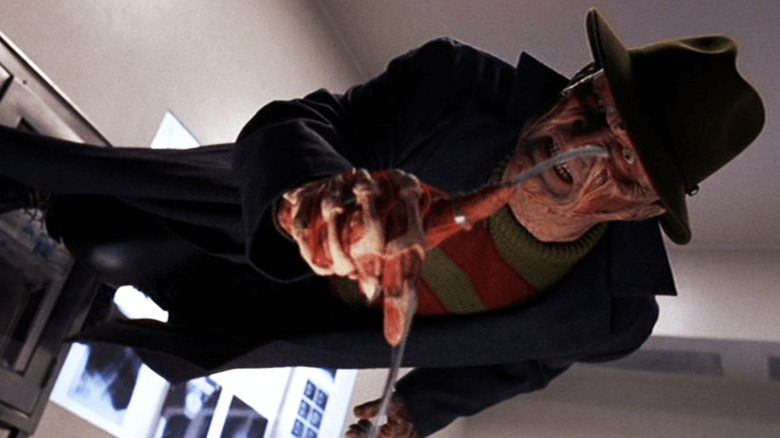
First off, both of these brutes are regional. With each terrorizing specific fictional towns, one might make the mistake of thinking that a scuffle could never come to fruition in the first place. But that's no fun!
Pennywise theoretically could leave Derry whenever It pleases, but throughout the franchise, It stays put in Derry. As for Freddy Krueger, he's found a few ways to leave the sleepy town of Springwood, whether it be visiting Camp Crystal Lake in "Freddy vs. Jason" or more notably, in "Freddy's Dead: The Final Nightmare" where he's absorbed so many victims' souls that he became powerful enough to transcend the limits of dreams and reality and uses his daughter, Dr. Maggie Burroughs, as a vehicle to shatter the bounds of Springwood. For the sake of argument, let's say that Maggie didn't actually blow dear ol' dad to smithereens and instead, Freddy has been slashing teens across the country, when he learns about the highly-publicized mass disappearances of children in Derry, Maine.
It's the perfect cover: Freddy could make his way to Derry and continue killing kids with reckless abandon and likely go unnoticed, as unexplainable deaths in Derry are as prominent as dandelions in fields of grass. Freddy arrives and finds a great new home in Derry, as the city is a hotbed of fear, secrecy, and children claiming to have seen horrific visions. Honestly, Freddy could clean house, especially with Pennywise in hibernation for 27 years. Eventually, however, the crown prince must awaken, and with Freddy already hacking the Derry children to bits, he's just made it a hell of a lot harder for Pennywise to track down It's next meal.
Hold on to your red balloons and striped sweaters, because it's about to be a showdown of child-soul snatching slashers.

Derry is Stephen King's avatar of a typical New England town, and typical of King, the town holds more than a few dark secrets. If some Elm Street offspring were to make the grave mistake of wandering towards 29 Neibolt Street, it would be a real "out of the frying pan, into the fire" situation; someone should warn them not to look under the porch. The Standpipe, a Derry water tower that served as the setting for several child disappearances and drownings, was destroyed by the end of King's book, but beep beep, Georgie, not so fast -- even the site has a nasty aura to it (King's 2001 novel "Dreamcatcher" sees a visit to the site's memorial, tagged with graffiti proclaiming, "PENNYWISE LIVES").
There are plenty of hotspots for combat, but the main arena would likely be one of the still-standing spots where the killer clown from outer space likes to operate: the Derry sewers. Freddy Krueger would surely be right at home in the dank, damp tunnels underneath Derry, since he often brings his sleeping teen victims into not only the dream world, but to the very boiler room where he was burned alive. Think of it as a no-holds-barred underground cage match, where Pennywise can sink his yellow chompers into Freddy's neck as easily as Freddy can lop off the clown's white-gloved hand.
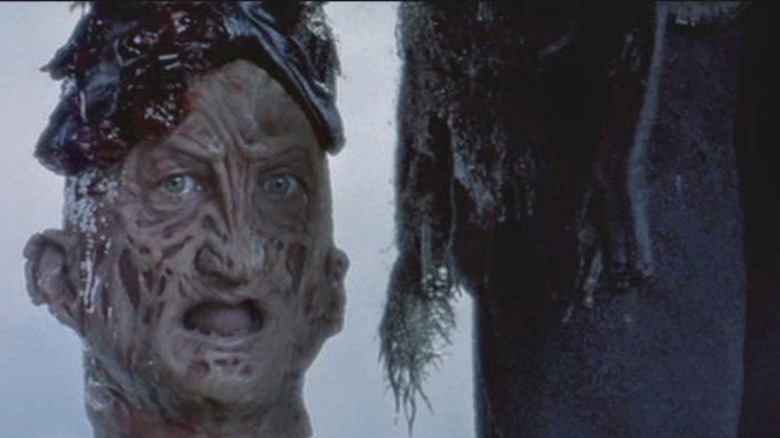
At first glance, things seem evenly matched. Both monsters can bend the rules of reality at will for their respective targets, turning a classroom nap into a trip to the boiler room or conjuring the scents of the circus to lure a child into chomping range. Each runs on tasty, tasty fear and/or children's myth-making in order to thrive, and both have been defeated by the unafraid (at least, until the sequel). But one has gotten their butt handed to them too many times to ignore. While it takes something as powerful and communal as the ancient Ritual of Chüd to conquer Pennywise, Freddy has racked up an embarrassing nine feature films' worth of losses. He's been decapitated, shoved in an oven, and in "A Nightmare on Elm Street 4: The Dream Master," he merely looks into a mirror and comes undone, clearly the easier of the two killers to overthrow.
The kill count makes the fight even more lop-sided: across the film franchise and generously including deaths from his "Freddy's Nightmares" TV series, the wisecracking slasher pulls a body count of 62 victims. Pennywise is harder to track because, as King's timeline shows, it is billions of years old (that's a long record of soul-eating). The documented numbers are devastating: the Kitchener Ironworks explosion of 1908 alone (set by Pennywise) was responsible for the deaths of 102 people, 88 of them children. That's just a taste -- King's novel credits the deaths of an entire town of settlers to the entity, over 300 of them. Not only is Pennywise the longer-established of the two, but it's far more effective at its' mission. Freddy can't quip his way out of this one -- Pennywise is the badder of the baddies, and Krueger is toast.
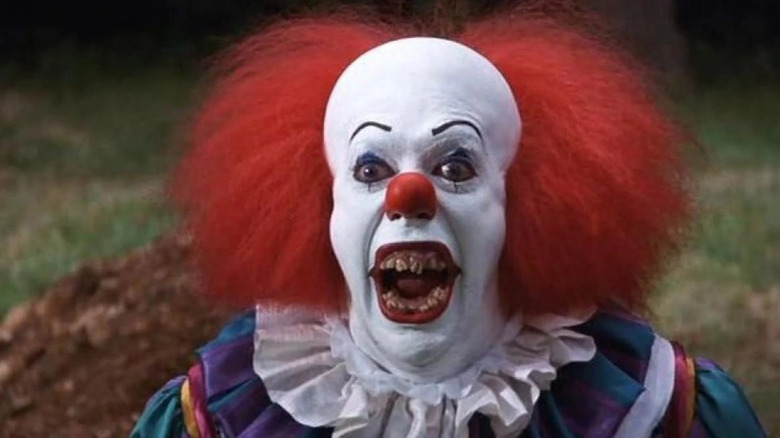
As a soul-eating dream demon, Freddy isn't going to let a pesky death cause him to stop anytime soon, so after he's licked his wounds and probably the telephone of an unsuspecting victim, he'll be back. Now that he knows what Pennywise is capable of enacting if he gets in his way, there's a good chance that Freddy will start to follow a similar feeding pattern as Pennywise, terrorizing Derry during the metamorphing terror clown's 27 year off-season, returning home to Elm Street just when the residents of Springwood think they're safe, and keeping everyone's least favorite red balloon salesman out of his melted hair.
As for the funnyman, It's still got a surprise or two up its ruffled sleeve. The 27-year hibernation is like the pirate's code: it's more of a guideline than a hard rule. Pennywise can emerge from its slumber in the ballpark window of three decades, so Freddy had better tread lightly, lest he get caught unawares (and in the deadlights) on the clown's turf. Like anyone waking up from a nap, Pennywise is unlikely to be in a chipper mood, leaving the Springwood slayer at the mercy of an even more furious-than-usual Pennywise. No matter how sharp those finger-blades are, Freddy will float, too.
Read this next: The 20 Best Zombie Movies Of All Time
The post /Film Showdown: Pennywise vs. Freddy Krueger appeared first on /Film.
We've now tested every version of Apple's M1 processor, from the first M1 chip in the 13-inch Macbook Pro all the way up to the M1 Ultra in the new Mac Studio, and the chip's ability to scale performance is pretty incredible. The M1 Ultra fuses two M1 Max chips together to get you a processor with 20 CPU cores and 64 GPU cores, along with up to 128GB of RAM, and it's one of the fastest processors we've ever tested.
We asked what tests you'd like to see run on the M1 Ultra and assembled quite a list, including Adobe Lightroom and Premiere Pro, Davinci Resolve and Fusion, 3D modeling in Blender, machine learning tests like TensorFlow and Pytorch, and even some gaming.
Amazingly, the M1 Ultra really does seem to be around twice as fast as the M1 Max in most applications. Whatever overhead is required to shuffle data around such a large chip, it rarely impacts CPU performance. The GPU scaling doesn't fare quite so well. The M1 Ultra was typically 40-80% faster than the M1 Max, still speedy, but not quite as impressive in its scaling as the CPU.
The M1 Ultra does best when its hardware accelerators can kick in. These are the parts of the chip built to speed up specific tasks, namely video rendering and AI processing. In a test processing ten 8K video clips at once, the M1 Ultra did the job in just 29 seconds when its accelerators were able to help out. This was about twice as fast as the PC we were testing, despite it having a 16-core AMD 5950X processor and Nvidia RTX 3080 Ti graphics card.
Apple's M1 ecosystem does at times feel unfinished. There were more strange bugs than I'd expected, and software compatibility can still be a problem, but it's improving rapidly. The M1 Ultra wasn't always faster than my PC, but in some tests it was two or three times quicker, and in only a few cases was it significantly slower. If you use Apple and need a high-end desktop, there's really no decision, and for everyone else looking for a workstation, the M1 Ultra Mac Studio is a contender.
Check out the video above for the full details of our testing.

The U.S. Coast Guard rescued a panicked dog swimming in the middle of the sea off North Carolina with nothing else in sight on Saturday (see video below). A call had just come in about a ship that had lost a dog in Pamlico Sound, an approximately 1,200 square-mile lagoon. — Read the rest

Trump's Wall has been defeated again with a tunnel linking Tijuana, Mexico and San Diego, California. According to AP, the 532-meter tunnel is four feet in diameter and six stories deep. In addition to electric power and ventilation, the tunnel has a rail system and reinforced walls. — Read the rest
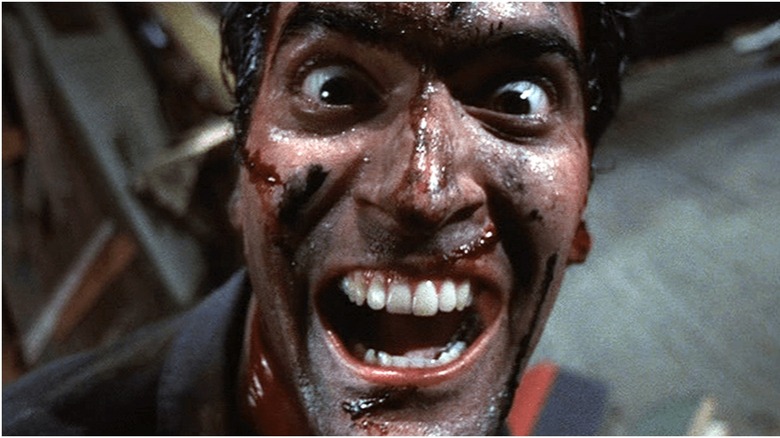
The king has returned! (Hail to the king, baby). After a nine-year hiatus from directing feature films, Sam Raimi returned to directing with "Doctor Strange in the Multiverse of Madness" and delivered what might be the best-directed movie in the Marvel Cinematic Universe while reminding us what we'd been missing during his sabbatical.
So, what exactly is it about Sam Raimi movies that makes them so unique? Why is his style so evident in any given moment from any of his films, even his superhero work? As with any auteur, if you look across his work, you'll see patterns both in the types of stories Raimi tells and how he chooses to tell those stories.
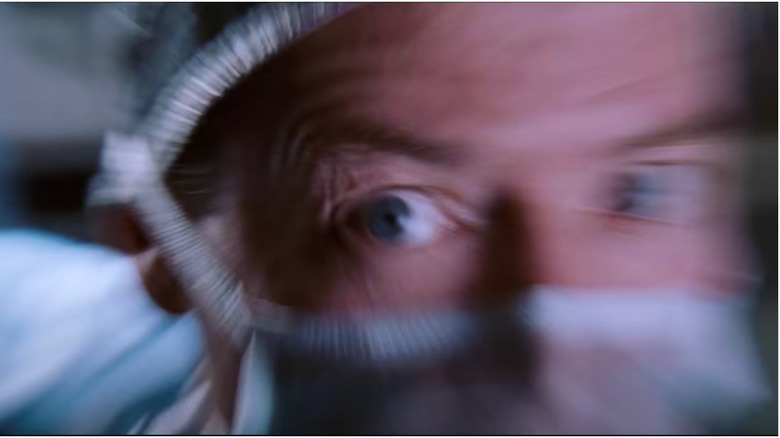
One of Raimi's absolute favorite camera tricks is a lighting fast zoom-in, usually into a character's eye. Once the camera gets as extreme as a close-up as can be, the scene will smash cut to a wide shot of the impact. The scene gets the subjectivity of the character about to be hit but unable to move away in time, and then the objectivity of what happens when they are hit.
One of Raimi's greatest uses of this is in "Spider-Man 2," specifically the Doc Ock (Alfred Molina) surgery scene. The lead surgeon spots a looming tentacle and when he turns around, it lunges. The camera zooms into the doctor's eye at a lighting-fast pace before cutting to a wide shot of the tentacle knocking its target across the room. Similarly, in the climax of "The Quick and the Dead," Ellen (Sharon Stone) shoots the shot that ends John Herod (Gene Hackman). The camera follows the bullet's POV as it enters Herod's eye and then smash cuts to a wide shot as he goes flying.
Raimi often uses handheld first-person POV, especially in the "Evil Dead" trilogy, where such shots are employed to show the world through the evil Deadites' eyes. The first movie famously ends with an unseen monster tunneling through the woods, into the cabin, then lunging at Ash, all seen through its eyes.
Raimi also loves his whip pans. In the bank robbery scene of "Spider-Man 2," when our hero (Tobey Maguire) is in Doc Ock's grasp, the shot cuts to Spider-Man's left hand. When he launches a web, the camera whip pans to a table, arriving on its new subject as the web makes contact. This camera movement repeats as Spidey webs a second table to his left before slamming them both into the villain.
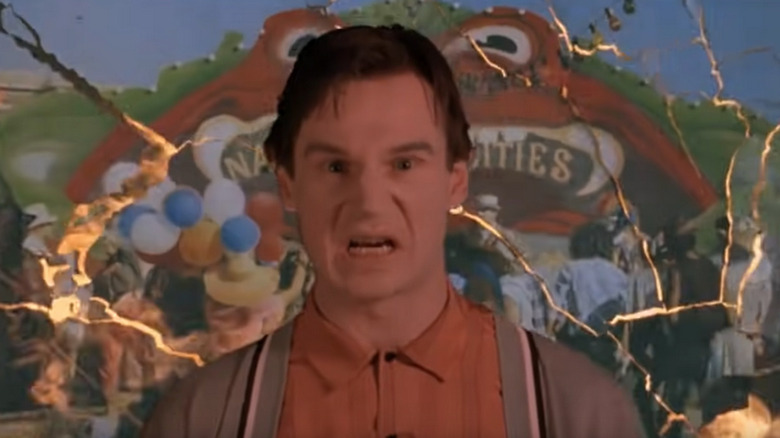
Raimi loves to move his camera, but when he wants to hold on a shot, how does he frame it?
Oftentimes, with dutch angles, aka, shots that are canted or askew. In the "Evil Dead" trilogy, dutch angles are Raimi's go-to method for signaling the presence of Deadites and framing close-ups of the horrified characters. Raimi is willing to go dutch just for a cool image though; take an early shot in "Evil Dead II" when Ash (Bruce Campbell) buries his girlfriend Linda (Denise Bixler). As Ash marks the burial with a make-shift cross, his whole body is visible while the camera sits on a low, tilted angle. This shot is recreated in the sequel "Army of Darkness" when Ash buries his evil self. During the seance scene in "Drag Me To Hell," Raimi likewise uses a dutch angle while the demonic Lamia leers over Christine (Alison Lohman).
"Darkman," Raimi's first foray into superheroes, features his most disorienting use of titled framing. Peyton Westlake (Liam Neeson) is afflicted with heightened anger after an accident leaves his face horribly burned and his nerves severed. When he's denied a carnival prize for his girlfriend Julie (Frances McDormand), he flips. Peyton is shot with dutch angles and in extreme close-ups while Julie is shot on an even axis from a medium close-up, emphasizing his over-the-top anger.
Raimi will also have his characters look into the camera, not to break the fourth wall, but to emphasize their reaction. One of the most famous shots in "Evil Dead II" is a close-up of a bug-eyed, blood-splattered Ash grinning maniacally as he looks straight ahead. The aforementioned "Darkman" scene climaxes with an enraged Peyton, fire erupting at his sides. Raimi combines this glare with his eye zoom, zooming in through Peyton's left eye and then pulling back through his right.
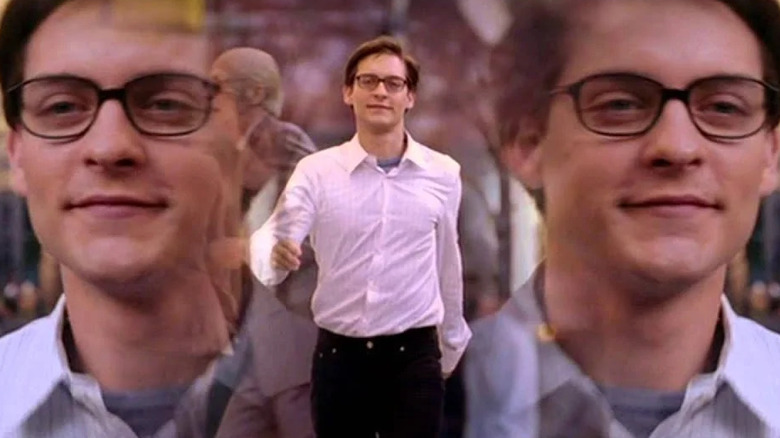
With how much mileage Raimi gets out of moving his camera, it shouldn't be surprising that he also loves a good montage. In "Spider-Man 2," after Peter quits super-heroics, the film shifts to a montage of him enjoying everyday life. Peter walks through the city carefree and catches up on his studies, all set to B. J. Thomas' "Raindrops Keep Fallin' On My Head" (the same song which played under a similar downtime montage in "Butch Cassidy and the Sundance Kid"). During this sequence, Raimi uses whip pans not within a single scene, but as transitions from one moment to another.
Raimi's first "Spider-Man" also used a montage for the scene where Peter designs his costume. This sequence exemplifies Raimi's preferred editing style, mixing cross-fades and overlays to show multiple subjects on the screen at the same time. When Peter first sees the ad for a wrestling competition, Raimi makes sure the audience knows exactly what's on his mind by placing a double exposure of Mary-Jane (Kirsten Dunst) next to Peter's head.
"The Quick and the Dead" has the best-constructed montage of all, showing the progress of the gunslinging competition. As duelers (set against a black background) kill or fall, the sequence intersperses close-up reactions from the main players, shots of the town clocktower, and a chalk whiteboard keeping tracking of the dead.
One of the best scenes in "Multiverse of Madness" is one of these cross-fade montages. Exposition typically grinds Marvel movies to a halt, but Raimi keeps the pace moving by emphasizing visual impact as much as the dialogue.
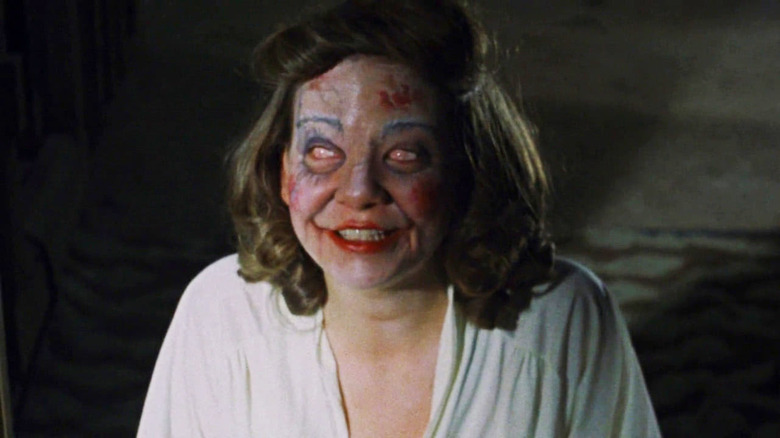
Now that we've explored how Raimi makes a movie, let's look at the types of movies he likes to make. First up: horror, the genre where Raimi cut his teeth. Even looking past "Evil Dead," the most memorable moments in his blockbusters are the ones with a scary edge to them. "Spider-Man" uses a jump scare when the Green Goblin attacks Aunt May and the fiery atmosphere of the scene mixed with Willem Dafoe and Rosemary Harris' pitch-perfect performances of malevolence and terror, respectively, make the scene genuinely scary in ways modern superhero movies don't approach.
Raimi isn't shy about gore either. "The Evil Dead" is a straight-up grindhouse splatter movie; the concluding minutes of the film are taken up mostly with shots of the Deadites dissolving in gruesome detail. The sequels don't tone this down -- both "Evil Dead II" and "Army of Darkness" have scenes of blood erupting like a geyser.
As Raimi told Den of Geek, the first horror movie he ever saw was George Romero's "Night of the Living Dead":
"I'd never experienced horror like that before. It felt so real, like a docu-horror. I had never seen a black-and-white movie in a movie theatre before; it looked like a documentary. There was nothing Hollywood about it – it was just unrelenting and complete madness and very upsetting for me."
The influence on Raimi is obvious: both "Evil Dead" and Romero's film are about the protagonists trapped in remote houses, besieged by the undead. Before the sequel introduces his chainsaw, Ash wields a shotgun, the same weapon used by Ben (Duane Jones) in "Night of the Living Dead."
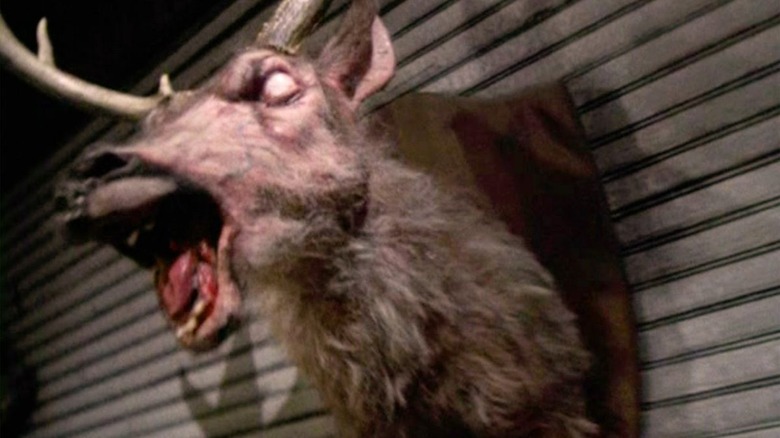
What makes Raimi's horror movies stand out is that they're not just scary, but also funny. It did take him some time to mix these seemingly opposite tones, though. "The Evil Dead" is horror exploitation played straight, a lowbrow "Exorcist" with the setting and grime of "The Texas Chainsaw Massacre." His second film, "Crimewave," aims for slapstick but falls on its own face, winding up not as a thriller comedy but a farce.
It's in "Evil Dead II" where Raimi is able to bridge his comedy and horror instincts for what's best described as "scary slapstick." The opening half of "Evil Dead II" is just Bruce Campbell's Ash stumbling through the cabin and being tormented by everything from a headless, reanimated Linda to his own hand. The imagery is scary, but the effect is comic.
Raimi and Campbell are both fans of "The Three Stooges," and this fandom bleeds over into the slapstick of "Evil Dead." According to Campbell, the scene of a lightbulb filling with blood then exploding is a nod to his favorite "Stooges" short, "A Plumbing We Will Go." One of Raimi's own favorite "Stooges" shorts is "Brideless Groom," featuring a scene where Moe accidentally bites his own hand. It's not hard to see this as the inspiration for all the trouble Ash goes through with his right hand in "Evil Dead II."
One of Raimi's go-to physical comedy moves is to send characters flying through the air, defying gravity like they're in "Looney Tunes." In "Darkman," Peyton frames one of Robert Durant's (Larry Drake) henchmen for stealing from the till, leaving stolen money and airline tickets in his apartment. Durant tells his seemingly treacherous henchman, "Have a nice flight." Smash cut to him plummeting out the window.
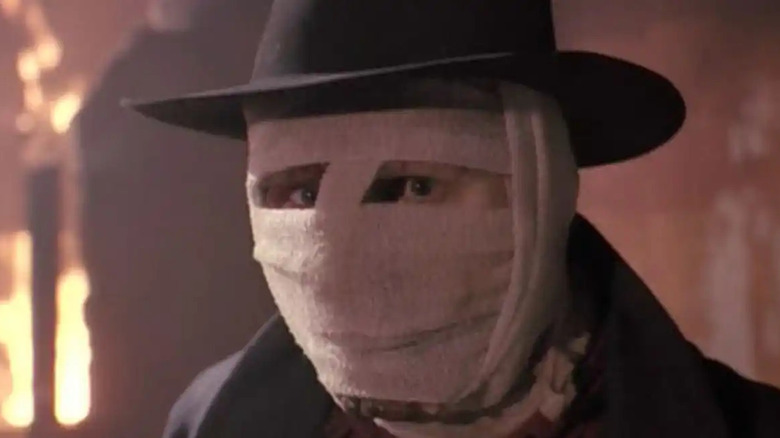
Raimi has a thing for mad scientists straight out of Universal Horror films -- the Green Goblin and Doc Ock fit the bill, while the blue-collar Sandman is still the product of science gone wrong. "Darkman," which is not the best Sam Raimi movie but may be the most Sam Raimi movie, flips the script by making the mad scientist the hero. Darkman's costume evokes the bandaged face of the Invisible Man (but with the black trench coat and hat of The Shadow).
Raimi's protagonists usually face ostracization; even his most privileged ones are down on their luck. Raimi explained the appeal of Peter Parker:
"The great strength of Spider-Man is the fact that he's a real person, he's one of us, he's a kid from Brooklyn who doesn't have a lot of money, he doesn't get the girls, he's got acne, he's a fairly average looking kid... he's one of us unlike Superman from the planet Krypton and other fantastic heroes. He's really a kid that we identify with."
Another character type that crops up is the doppelgänger. The villain of "Army of Darkness" is Evil Ash, also played by Campbell. In "Darkman," Peyton disguises himself as Durant and comes face-to-face with the real thing. This makes Raimi's antipathy towards Venom a bit surprising, but it does explain why Eddie Brock (Topher Grace) in "Spider-Man 3" is just an evil Peter Parker.
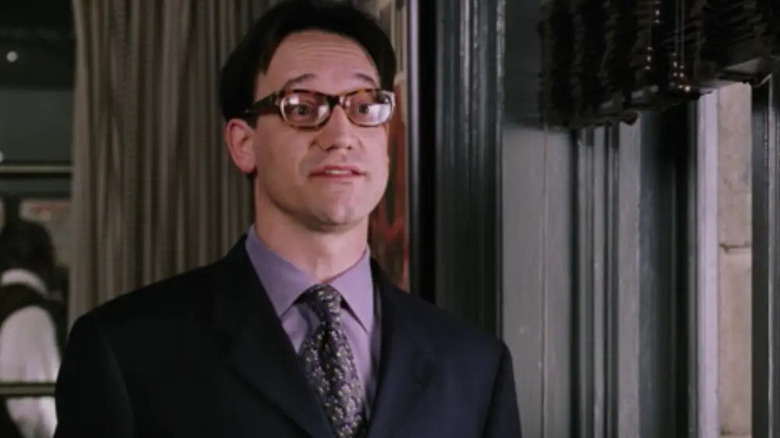
Raimi has a regular team of actors and behind-the-camera crew that he employs again and again. Most obviously, there's Ash Williams himself, Bruce Campbell. Campbell cameos in almost all of Raimi's movies, from appearing as Darkman's final disguise to his three distinct appearances in every "Spider-Man" movie.
Raimi also makes filmmaking a family effort. His younger brother Ted acts in many of his movies, most notably as Daily Bugle ad manager Hoffman in the "Spider-Man" trilogy. His older brother Ivan (who works primarily as a physician) has screenplay credits on "Darkman," "Army of Darkness," "Spider-Man 3," and "Drag Me To Hell."
Composer Danny Elfman has worked on seven of Raimi's 15 films; his operatic music fits Raimi's heightened tone. Raimi's usual directors of photography are Bill Pope or Peter Deming, while his usual editor is Bob Murawski. Raimi is also a friend of the Coen brothers and in the early days of their careers, they often collaborated.
In other words, it takes more than just Sam Raimi to make a Sam Raimi movie.
Read this next: The 20 Best Westerns Of All Time
The post What Exactly Makes A Sam Raimi Movie A Sam Raimi Movie appeared first on /Film.

In a new marketing slide published by AMD, the company claims that its Radeon RX 6000 GPUs lead in both pricing & efficiency versus NVIDIA's RTX 30 series.
The slide in question was tweeted by AMD's Chief Architect of Gaming, Frank Azor which showcases both the performance per watt and performance per dollar of AMD's entire Radeon RX 6000 lineup against the NVIDIA GeForce RTX 30 series. The list of GPUs include all the way from the fastest AMD Radeon RX 6950 XT to the entry-level Radeon RX 6400.
AMD has used street prices of the cards for comparison and not the MSRPs. Based on the metrics, the AMD Radeon RX 6000 series lineup offers:
AMD has claimed up to 89% better performance per watt when comparing its new RDNA 2 Radeon RX 6400 graphics card to a several-year-old GTX 1050 Ti graphics card. The second-biggest increase comes from the recently released flagship, the RX 6950 XT which provides a 80% uplift over its RTX competitor, the GeForce RTX 3090, with an 80% higher value. With that said, AMD also shared the performance per watt metrics for its Radeon RX 6000 series lineup which can be seen below:
AMD also lists down each specific gaming tier that these cards are meant for. The Navi 24 offerings such as the Radeon RX 6500 XT & RX 6400 are meant for 1080p Medium gaming, Navi 23 offerings are designed for 1080p Max, the Navi 22 offerings that include RX 6700 series are designed for 2K Max while the Navi 21 offerings aim for the 4K maxed out the segment.
Once again, the prices are the lowest as seen over at Newegg on the 10th of May, 2022. With the ever-changing prices, this chart may become invalid soon but it looks like AMD & NVIDIA are aware of the fact that with prices dropping and availability improving, gamers are now going to look for a new solution for their PC and both companies are trying their best with marketing and promos to entice gamers to buy their current-generation graphics cards. AMD and NVIDIA have already done marketing around the availability of these cards and the red team also recently announced to do a full relaunch of their 'Raise The Game' bundle.
| Graphics Card | AMD Radeon RX 6950 XT | AMD Radeon RX 6900 XT | AMD Radeon RX 6800 XT | AMD Radeon RX 6800 | AMD Radeon RX 6750 XT | AMD Radeon RX 6700 XT | AMD Radeon RX 6650 XT | AMD Radeon RX 6600 XT | AMD Radeon RX 6600 | AMD Radeon RX 6500 XT | AMD Radeon RX 6400 |
|---|---|---|---|---|---|---|---|---|---|---|---|
| GPU | Navi 21 KXTX | Navi 21 XTX | Navi 21 XT | Navi 21 XL | Navi 22 KXT | Navi 22 XT | Navi 23 KXT | Navi 23 (XT) | Navi 23 (XL) | Navi 24 (XT) | Navi 24 (XL) |
| Process Node | 7nm | 7nm | 7nm | 7nm | 7nm | 7nm | 7nm | 7nm | 7nm | 6nm | 6nm |
| Die Size | 520mm2 | 520mm2 | 520mm2 | 520mm2 | 336mm2 | 336mm2 | 237mm2 | 237mm2 | 237mm2 | 107mm2 | 107mm2 |
| Transistors | 26.8 Billion | 26.8 Billion | 26.8 Billion | 26.8 Billion | 17.2 Billion | 17.2 Billion | 11.06 Billion | 11.06 Billion | 11.06 Billion | 5.4 Billion | 5.4 Billion |
| Compute Units | 80 | 80 | 72 | 60 | 40 | 40 | 32 | 32 | 28 | 16 | 12 |
| Stream Processors | 5120 | 5120 | 4608 | 3840 | 2560 | 2560 | 2048 | 2048 | 1792 | 1024 | 768 |
| TMUs/ROPs | 320 / 128 | 320 / 128 | 288 / 128 | 240 / 96 | 160/64 | 160/64 | 128/64 | 128/64 | 112/64 | 64/32 | 48/32 |
| Game Clock | 2116 MHz | 2015 MHz | 2015 MHz | 1815 MHz | 2495 MHz | 2424 MHz | 2410 MHz | 2359 MHz | 2044 MHz | 2610 MHz | 2039 MHz |
| Boost Clock | 2324 MHz | 2250 MHz | 2250 MHz | 2105 MHz | 2600 MHz | 2581 MHz | 2635 MHz | 2589 MHz | 2491 MHz | 2815 MHz | 2321 MHz |
| FP32 TFLOPs | 23.80 TFLOPs | 23.04 TFLOPs | 20.74 TFLOPs | 16.17 TFLOPs | 13.31 TFLOPs | 13.21 TFLOPs | 10.79 TFLOPs | 10.6 TFLOPs | 9.0 TFLOPs | 5.7 TFLOPs | 3.5 TFLOPs |
| Memory Size | 16 GB GDDR6 +128 MB Infinity Cache | 16 GB GDDR6 +128 MB Infinity Cache | 16 GB GDDR6 +128 MB Infinity Cache | 16 GB GDDR6 +128 MB Infinity Cache | 12 GB GDDR6 + 96 MB Infinity Cache | 12 GB GDDR6 + 96 MB Infinity Cache | 8 GB GDDR6 + 32 MB Infinity Cache | 8 GB GDDR6 + 32 MB Infinity Cache | 8 GB GDDR6 + 32 MB Infinity Cache | 4 GB GDDR6 + 16 MB Infinity Cache | 4 GB GDDR6 + 16 MB Infinity Cache |
| Memory Bus | 256-bit | 256-bit | 256-bit | 256-bit | 192-bit | 192-bit | 128-bit | 128-bit | 128-bit | 64-bit | 64-bit |
| Memory Clock | 18 Gbps | 16 Gbps | 16 Gbps | 16 Gbps | 18 Gbps | 16 Gbps | 17.5 Gbps | 16 Gbps | 14 Gbps | 18 Gbps | 14 Gbps |
| Bandwidth | 576 GB/s | 512 GB/s | 512 GB/s | 512 GB/s | 432 GB/s | 384 GB/s | 280 GB/s | 256 GB/s | 224 GB/s | 144 GB/s | 112 GB/s |
| TDP | 335W | 300W | 300W | 250W | 250W | 230W | 176W | 160W | 132W | 107W | 53W |
| Price | $1099 US | $999 US | $649 US | $579 US | $549 US | $479 US | $399 US | $379 US | $329 US | $199 US | $159 US? |
The post AMD Marketing Claims Radeon RX 6000 GPUs Offer Better Performance Per Dollar & Higher FPS Per Watt Versus NVIDIA’s RTX 30 Series by Hassan Mujtaba appeared first on Wccftech.
Read more of this story at Slashdot.
Read more of this story at Slashdot.